#i just want historically accurate fashion in modern day media
Text
Corset or Stays?
Alright as someone who enjoys reading fantasy (typically a historical setting) and someone who loves fashion history I would like to quickly make differences between corsets and stays, what they look like, and bust some quick myths and facts.
(If you know more about this than me please correct me. I'm not a professional, just very passionate)
Stays:
Stays were not the original but were the first well-known "corset" and came before the now well-known "torture device".
Just like its predecessors stays were made to support the bust and typically had a lengthening effect on the torso. They were typically fully boned bodices worn under clothes.
They gave the body the typical cone shape that was desired at the time.

^ Queen Elizabeth 1 funeral stays

Bodies:
In the seventeenth century there was not much of a firm distinction between under and outerwear as we see later when it comes to bodies. So "bodies" could be either outerwear or underwear, it all depended on the woman.
Bodies are a stays-like garment. These are what people think of when they depict a character wearing their "corset" on the outside of their clothes.
Many of these garments have detachable sleeves indicating that the use of this garment was flexible and could be easily manipulated depending on the situation.
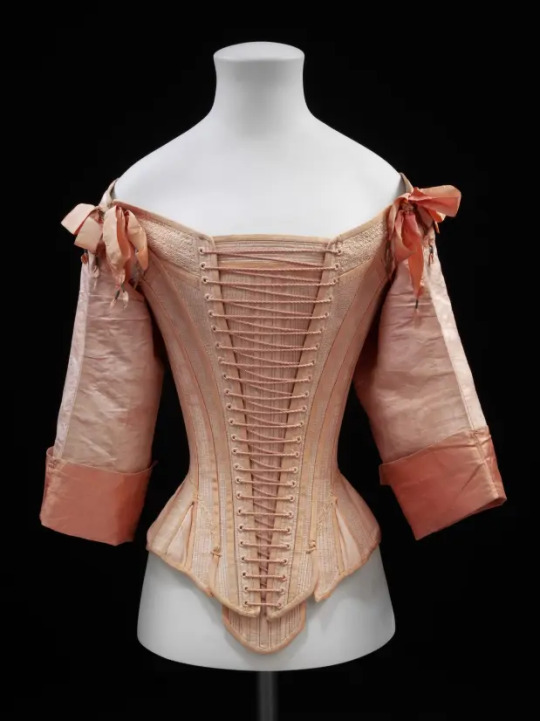
^ Bodies with detachable sleeves. Circa 1660-1670
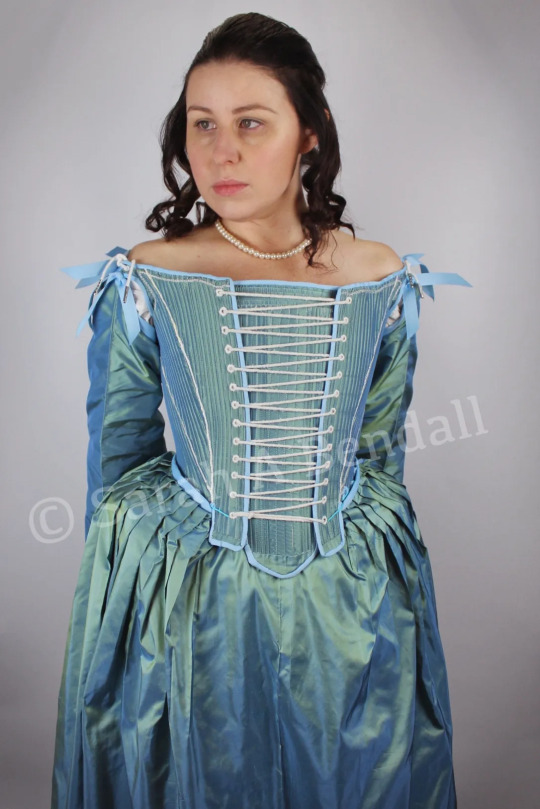
^ 1660s gown recreation
Corsets:
The all-popular torture device that was never actually a torture device. Corsets were to assist in making an hourglass shape but were never the main cause.
Corsets were underwear and laced in the back with clasps at the front.
Many believe that corsets would be constricting, stop breathing, be uncomfortable and be outright horrid to wear but if that was true why did women wear them for so long?
Tightlacing was the main cause of these issues but was never as popular. For a time men noticed that women were fainting and then suddenly stopped. This was because women realised tight lacing sucked.
Additionally, many of these myths came from doctors at the time. These same doctors believed that consuming arsenic was a cure-all. Even men wore corsets!
Everyone wore corsets, the type of corset just depended on how much wealth the person had. Many historical shows and books have that scene where the maid is tightly lacing her mistresses corset and depict it as horrid and uncomfortable when in reality the maid would have been wearing one too.
Overall many historical sources and modern sources have said that corsets are very comfortable and nice to wear.

^ Pink satin corset, Circa, 1890
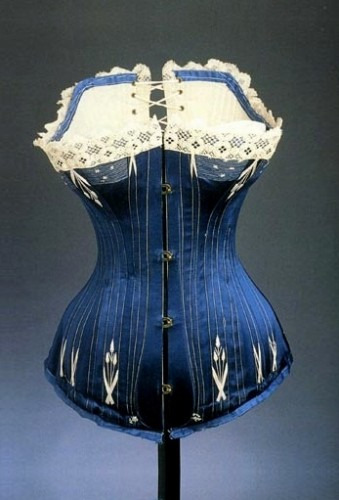
^ Blue silk Corset, circa 1890
Overall Corsets, Stays, and Bodies were all typically very comfortable and not one to complain about and all look very different. None of them actually made the main shape, layering and padding helped make the illusion of that.
Anyway, here's what i know and please do your own research before you believe a stranger on the internet.
#history#fashion history#corset#stays#information#Please im crying#i just want historically accurate fashion in modern day media
2 notes
·
View notes
Text
i'm procrastinating answering all the comments in my inbox, so instead i'll waste my time making a post about 3x3, you're welcome :):):)
right, so the historical costumes on tvd aren't always very ... historical, but the twenties are one era they tend to get mostly right. i say mostly because it's not perfect, and you can see the cracks if you know what you're looking for (we owe a huge part of our perception of the twenties not to the twenties themselves but to the resurgence of that aesthetic during the 50s and 60s, which wasn't necessarily accurate. most media today, tvd included, take inspiration from that era.)
HOWEVER, there's a thing about costuming in 3x3, aka THE twenties episode of this show that i absolutely adore, i think it was a brilliant move character-wise and ALSO showcasing an aspect of the twenties that isn't often talked about or shown on modern media ... and it's also probably on accident. i mean. let's be fair here.
anyway, i'm talking about rebekah's HAIR in this episode.
for context, this here's the style:

it's curled and pinned up into a bob. keyword, pinned up. in case you can't see it, here's her after she's been awoken in 2010, and the style's falling apart:

and her a few episodes later in modern clothes, literally days after, with shoulder-length hair:
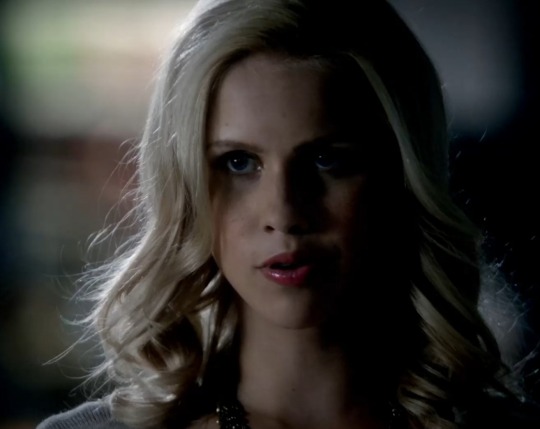
conclusion, rebekah's hair has been long all along. now, i don't know exactly where on the timeline the twenties flashbacks are (and as usual with me, unless it's stated explicitly in s1-3, i don't really care what canon has to say), but i like to put them somewhere around 1927, definitely later in the decade, based on how short the women's hems are. the transition between long edwardian skirts and the twenties' knee length dresses was a very long process.

point is, despite fashions of the era, she's had long hair for years. this ... was a real thing that women did. specifically, the style is called the faux bob, and it was a way of pretending you'd bobbed your hair as fashionable women did, while still keeping your long luscious locks that had been in fashion your entire life, your mother's entire life, your grandmother's, and so on and on and on, dating back for as long as memory serves.
(actually, in 3x20, you can see our girls doing the same thing for the decade dance, since they, i presume, didn't want to cut their hair just for one single evening. ALSO, the hems seen that evening are usually too short, owing again, to the glamourisation of this era in the later decades, which is also a nice touch.)

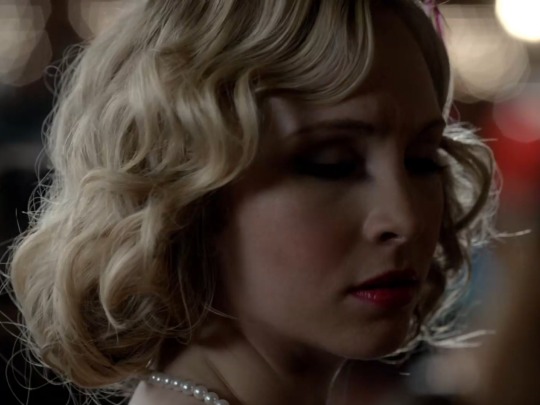

and this??? it's not only historically accurate, but i also love that for rebekah, who had already been alive (undead?) for nine hundred years in those flashbacks, has worn her hair long for this entire time, and would have an even more difficult time parting with it than young women of the time.
it cannot be overemphasised how radical a change in women's fashions the twenties brought about. the shorter hemlines are only a part of that--it was also for the first time fashionable to wear bold makeup and short hair (which this entire post is about). the advancements in technology allowed for the production of faux jewellery (those long strings of pearls you think about when you think twenties would've been far too expensive for many women if they were real) which meant that wearing statement pieces was no longer restricted to just the upper crust, and mass-production of clothes, which had previously been exclusively hand-made, and that contributed to the huge increase in speed at which fashion started evolving.
anyway, i love the idea of rebekah, who has been around for so long and seen so much, valuing her hair the same as she's valued it in her human days. i am completely aware that the reason they did this was so the actress wouldn't have to cut her hair, but i think that anyone who's ever seen and enjoyed tvd is aware that all the best parts of it are accidental anyway.
18 notes
·
View notes
Text
Bridgerton & Deliberate Historical Inaccuracies
Bridgerton is not historically accurate. We know this. We don't care. I think it's fine. And who cares, really, if they fudge a thing or two? It's a fantasy. There's no need for it to be accurate about fashions, society, race, language, etc.
But the biggest category I, a Regency scholar, notice the historical inaccuracies in is not about annyyyy of the above.
It's about repression.
Specifically, ignoring very real repression or choosing to reframe it (race and a woman's place being examples) and adding in repression and ignorance that is easier for the audience to swallow. The kind of repression that makes us roll our eyes OR be scandalized ... not the sad, cruel, evil kind that actually happened.
My two biggest examples?
The ignorance about sex.
WOMEN OF THIS ERA WERE NOT IGNORANT ABOUT SEX TO THIS DEGREE.
This is because, like today, Regency women talked amongst themselves ... and because it wasn't that taboo of a subject. (You're thinking of the Victorian era with the "that was taboo" stance, and even then, everything kinky just went underground and therefore got more alluring. The Victorians were freaks.)
Have you read Jane Austen? Or like, any Gothic fiction? Or like ... books? Have you read books!?
If nothing else, there would be a series of discussions in an upper class household with daughters as they became teenagers in a "and that's why men are pigs and you should wait until marriage and then only think of Scotland" kind of discussion.
But even if there was a very sheltered (usually very religious or something like that) young woman in the Regency era who had not learned of sex, that is not the Bridgerton girls. I mean, they have THREE older brothers who are all RAKES.
In season 1, literally what does Daphne think "rake" means? Like, he ... goes and gardens? "Ah, yes, my brother Anthony, GARDENING with that OPERA SINGER how horrible." Like, in the setup the show sets up, SHE CANNOT BE THAT NAIVE.
Now, this one I do not think is purely the decision of the directors. It's a common (inaccurate, annoying) trope in historical erotica because for some reason, historical erotica writers have a kink about being all innocent and deflowered by a hunky rogue who you can't resist because you just CANNOT and it's his fault not yours you are innocent you're just a baby. (Y'all coming off purity culture or something? How's the therapy coming?)
2. The period thing.
Women in the Regency era did not just bleed all over their sheets/clothes/etc. Especially not upper class Regency women with means.
They had menstrual products. Granted, made out of cloth, and granted, probably not as effective, but they had systems set up.
And further, they probably were more aware of their cycles than we are today because it was a valued thing to have a period. Because it meant you were (probably, somewhat inaccurately) fertile and could bear children for your husband. So, sexist as that reason is, this idea that women a: didn't know much about their periods and b: didn't manage them in a sustainable way is hogwash.
Further, the fact that these chicks HAD PERIODS means they know why they're bleeding, right? 10/10 they do. I am not taking criticism here.
3. The corsets
*sigh*
We've all heard the corset drama.
And that's fine. I don't care. But I can't help but feel like the reason they WERE using inappropriately-sized, uncomfortable corsets that were more modern or Victorian in style is BECAUSE they wanted the actresses to get uncomfortable (or even injure themselves) and complain and get the media riled up about it.
Because if they had just used period-accurate stays (or even period-accurate corsetry), they wouldn't have ever had this conversation in the first place.
I am somewhat confused, though, because every chick on Bridgerton that I've seen get undressed was not wearing a corset or stays, but that's a conversation for another day.
Just ... I feel like Bridgerton chose its inaccuracies very carefully to craft a specific type of society, and that's fine. Again, it's a fantasy. Really, if you care, you're giving this far too much energy (and I already have given it far too much energy lol). But ... it just is something to be aware of.
5 notes
·
View notes
Text
2 minutes into Bridgerton's first episode and I'm already mad. At least they had properly fit corsets and they didn't try to put the foot on her back to tighten.
AS A DRESS HISTORIAN and someone who wears a heavily boned 1889 corset almost every other day (I have back issues and proper corsets relieve so much pain) let me tell you leaning forward while lacing? That's a great way to improperly lace lol (especially when we're talking regency era and we're likely seeing wooden center busks in those things) I just lost a bunch of ranting bc i hit a button somewhere but the short version is go google "regency short stays", they're fairly similar to a modern bra. And sport corsets existed, prior attire goes swimming in one in a video, just like sports bras exist now. Regency era had so many options for undergarments and because of where the waist hit on the silhouette (right under the boobs) not a lot of shaping was needed below the waist of the silhouette. Long stays existed, sure, fashion changed so fast then but regency is generally the most comfortable era for people new to fashion history.
The whole fucking scene is problematic for women and honestly it's such a tired trope i don't even want to continue watching lol
I can count off the top of my head 5 identical scenes from different genres spanning almost a hundred years and I know there's more. When are we gonna get tired of this women hating trope, I'm so exhausted of being told lies to my face by media bc haha woman stupid, they don't need rights, haha.
Please, please read up on undergarments and clothing of the 19th century (modern panties are evil?) if you're into period dramas, I know it's a lot info but it's astonishingly simple. If you can't read go on over to youtube and look up:
-Priore Attire (historical sewing and fashion showcase)
-Abby Cox (fashion history, Nicole Rudolph's former neighbor and business partner, deep dives, sewing, antique clothing showcase)
-Karolina Żebrowska - (fashion history with a focus on Polish fashion)
-Morgan Donner - (everything you need to know about medieval fashion, historical sewing and textile work)
-Bernadette Banner - (victorian/edwardian fashion historian, ACCURATE historical sewing [by hand and on a period accurate antique machine even], she's written a book, she has skillshare classes, she also has the unique view of corseting with scoliosis, she is so incredibly knowledgeable and has a nice voice lol)
-Nicole Rudolph - (fashion historian, Abby Cox's former neighbor and business partner, co founder of american duchess, shoemaker, antique clothing showcase and replication, historical sewing)
The MET has a website, archive.org has free books (I streamed a historical sewing stream once and was able to actually go look up a historical ad for the exact type of corset I was making from a book from 1845, they have everything there), hell, type historical sewing into google and you'll be flooded.
IF YOU WANT GREAT HISTORICAL FASHION IN YOUR MEDIA I urge you to watch The Nevers, some of the best I've seen in the last little bit, right down to a fancy mismatched petticoat making an appearance and actual action fighting in actual corsets. It's not fully accurate and Joss Whedon worked on the first few episodes before they kicked him but it is a great show and has great fashion
#please save me from this nightmare#mainstream media will have you believe corsets are the devil#actresses are PAID to say they're uncomfortable!#can you fucking believe that#you should#and also corsets made for movies are not fitted to the actress like an actual corset would be#they're made in a general size close to the actress#so they're lacing down in an improperly fit garment#imagine wearing doc martins that are a size too small#or too narrow#doc martins are not uncomfortable#but if they don't fit they are#real fitted corsets are not uncomfortable because they're restrictive#they're usually uncomfortable bc they force good posture lol#Karolina has gone on record saying the only reason she gets sore in stays#is because it forces her not to slouch lol#but that's what they're for!#I have a work corset that I wear when I'm sewing or at my pc for work#because it keeps my back from getting sore#from hunching over#I encourage you to fucking read#maple RANTS
7 notes
·
View notes
Text
TMA RESEARCH - “APPEALING TO THE TARGET MARKET AUDIENCE”
Target Market Research is an essential stage in any marketing project.
and as such this module would not be doing itself justice if it didn’t appreciate the extent in which I’ve gone to with my research, so far, and will continue to do so..
in order to appeal to our target market audience; we need to do some research into their universal interests; and what better way to understand the interests of Gen-Z / Millennials than to look where such valuable data is eternally catalogued:
the internet.
I have opted for using the internet as a tool for retrieving this data; as it will allow me a unique opportunity to get a combination of the most current, and historically accurate data.
the process of decoding archival data is only possible through actually having this data - and the accuracy of said statistics is best represented through the search analytics, across the different internet browsers, over time.
as opposed to the first-hand research methods I had used for this course which included holding focus groups, as well as plenty of interviewing; where there is more of a front put on to protect yourself from what could be seen as embarrassing, untrue, and or unthought of;
I instead argue that it would be more beneficial to studying these strange breeds of human being using the archival potential of years of proven analytical data, and as such will do so using it.
SEARCHING FOR A TOPIC TO SPARK INSPIRATION FROM - “THE EPIDEMIC OF 80′S FEVER”
using global analytics I looked across the globe to see what sort of things were currently trending, amongst our age range of Gen Z and Millenials and to start with eliminated all of the commonplace buzzwords like ‘drama’, ‘fail’, etc.
my original plan was to manually use a dropdown menu to eliminate search results I thought were too topical, out of concern that due to the Covid 19 pandemic the current state of internet usage has since doubled, and as such people are using it more - over-saturating it with content, and thus decreasing the shelf-life of what is popular.
with this, I wanted to ensure that I would not pick a topic that could possibly lose its relevance by the time this module was over; and as such, I looked more broadly than trending keywords and instead turned my attention to topics.
as always, animals were very high up there, as well as people getting hurt, but one subject eluded me enough to catch my attention and force me to research deeper.
( and if the title didn’t give it away; I’m honestly shocked..)
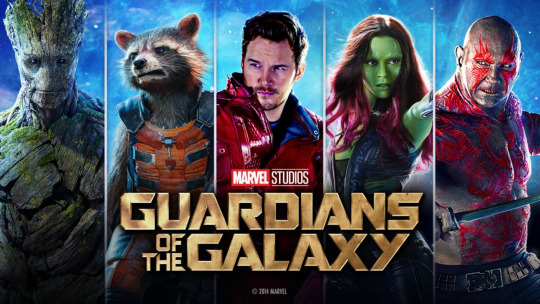
2014 saw the release of Marvel’s ‘Guardians of the Galaxy’ a science-fiction adventure film starring a rogue group of intergalactic criminals who team up to keep a valuable orb out of the hands of one evil ‘Ronan the Accuser’.
it’s thematic setting is due in part to the character of StarLord who is a comedic blast from the past; dancing to a ‘wicked good’ tape deck on his Sony Walkman that compiled all the greatest tunes of the ‘80s.
this film is often held responsible for the resurgence of 80′s culture, within modern society: and as such caused a substantial spike in said topic, that I thought to have been long dormant..
however, this was not the case

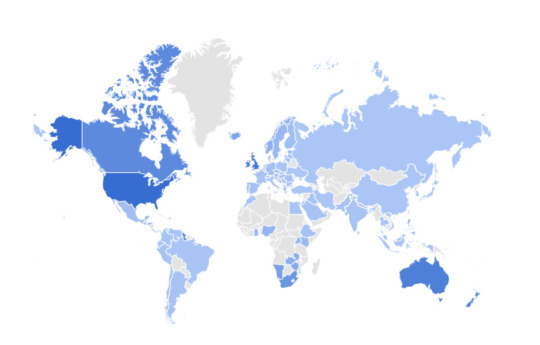
looking around, the more you think about it, the more obvious it is: with current day fashion heavily leaning into elements from the past, with a substantial majority of men now rocking moustaches, and mullets - it is a sign that this resurgence of 80′s fever, is seemingly only just kicking in..
as such, I think I’m going to be using this as the baseline for my film - and will research into the topic, later on down the line in an attempt to find a way to blend modernist humour, with 80′s fever to create a compelling and interesting end product.
SOCIAL MEDIA - “A NEW AGE INTERNET”
for most companies whilst rebranding to appeal to a new generation: the first step is to introduce themselves to the current era using social media, and as such: I thought to check William Lawson’s internet presence.
I decided to check what the brand’s social media situation was; and found that they had accounts and were available to follow on Twitter, Instagram, Linkedin and YouTube.
however, William Lawson’s is most active on facebook - posting often to their 953,877 followers, as of the time of writing this blog post.
this is part of why the brand is limited in it’s consumer-base; and should expand to posting this level of consistent updates to the rest of the socials in order to reach as many people, as possible - and thus increase the likelihood of having a younger audience base.
the memes they post aren’t exactly top tier levels of comedy; but nor are they offensive in any way - and as such, it will only do good with them being widespread across all platforms.
it’s here on the internet that I wanted to focus my attention once, more: as I showcase a very limited and simplified timeline of events that tell us how we, as a generation have come to the current state of post-ironic humour; and finally found a way to incorporate the modern style of humour into media.
APPEALING NOT PREACHING - “FINDING A BALANCE”
growing up, I seemingly missed out on the era of childhood people so fondly remember where they describe watching Nickelodeon shows such as Victorious, Zoey 101, and Drake & Josh
however, amongst these shows was Icarly, which I’ve come to learn was a powerhouse of the early 2000′s Nickelodeon line-up.
Icarly was a show that followed a girl and her best friends hosting their own web-show called iCarly from their apartment.
it’s full of very early Nickelodeon staples of humour; with loud noises, slapstick comedy and plenty of subliminal foot fetish content courtesy of Dan Schneider, himself..
youtube
youtube
during the show’s air; popular YouTuber Fred was the first user on the site to surpass 1 million subscribers; and with his new found celebrity status, he was invited to be a guest-star on the show.
it was here that we saw Nickelodeon dipping their toes into the idea of toying around with bridging the gap between the internet and television..
the special was apparently fine enough, for the show: with the two mediums bouncing off each-other relatively well due to their similar premises - with Icarly & Fred both being internet web show creators.
and with every big fish comes a leech on the belly:
youtube
after the success of Icarly - Nickelodeon kept chasing the wave; and attempted to bring in some fresh-faced children to carry a new series for ‘years to come’.
however, when trying to create a show; it’s important to flesh out characters and not to create one-dimensional roles to fill, with no charm or personality.
out of fear of television as a media dying, and the company being left in the dust; Nickelodeon apparently shilled out show after show in similar manners to this, and with each commercial failure companies became less and less interested in investing their money in projects that followed the internet, and soon fell a stigma with audiences that the internet and television were incompatible and could not mix, well
at least whilst out-of-touch show-runners were behind the scenes...
youtube
Newgrounds content creators Chris O’Neil (OneyNG) and Zach Hadel (psychicpebbles) attempted to pitch their popular internet series ‘Hellbenders’ to Adult Swim - but were turned away, after what was described as “the worst pitch they had ever heard”.
the world truly was not ready for the possibility of freely outrageous internet humour and the harsh censorship rules of television combining, yet: a climate that began to change, as a transition to the digital age became more and more common-place for elements of everyday life.
youtube
as time passed; more and more people were using the internet, and as such; it became more commonplace for the general public to be exposed to the weird and wild side of internet-based humour; and as such the potential for blending television and the internet is finally managing to take form, with shows like Michael Cusack and Zach Hadel’s ‘The Smiling Friends’ being commercial successes and paving the way for a potential new type of content, separate from both pre-existing entities.
REVERTING BACK TO THE POINT AT HAND - “DOING ‘INTERNET HUMOUR’ RIGHT”
internet humour, is slowly just becoming ‘regular humour’ and as such, this is not something that needs to be stressed about, as much as people collectively imagine it to be.
how many times in a daily conversation do you reference something from the internet; whether that be recommending a video you watched, quoting a particularly funny phrase that’s popular with your friend-group, or opening up your phone to pass the time.
the internet has become an integral part of day-to-day life for some; and as such its humour blends with it to some degree.
much like all things - it’s important to strike a balance: and this is exactly what needs to be done;
with a fair blend of build-up to reach a good punchline: so far, I’m thinking it would be good to see something that twists viewers perceptions?
potentially keeping a sense of normalcy to ensure relatability through having a seemingly happy and light-hearted film suddenly turn dark, through a character death, cutting straight from a story following them to a funeral or something that is so out of left field that the tragic nature is overridden by shock and this influx of emotions causes people to laugh.
with a good starting point, plenty of research and a new understanding of both topic and humour for our film, now under my collective belt - I feel comfortable to change a course, and run with this new found direction to create a brilliant final outcome to be proud of.
0 notes
Note
I am really glad you said your piece about that historical fashion post cause insisting that passion and art cannot coexist with historical accuracy in shows, that are marketed SPECIFICALLY as being set in a specific era, sounds very dismissive and condescending of the effort fashion historians put into educating people about historical costume, and how its portrayal in media affects the perceptions the audiences have of it
YEAH thank u
problem is NOT with shows like ofmd but i am like.
urgh okay so i keep mentioning anne w an e let me explain.
latest episode i watched. woman in it. wore pants. no corset.
made me very upset.
erased a bunch of real history about women. victorian women made very cool skirts that turned into pants for riding bikes. they were not helpless. they were working women. they refused to be held back. they wanted to ride a bike, so they made a way to ride it. that is so cool. that's how progress is made.
but instead of showing that we will just give her pants.
why?
why why why?
n it's never with men. i mean men's clothing its own bag of worms. but still. never ever with men. men wore corsets sometimes. men had style. never bother with that tho. just put them in suit and call it a day. i don't have an eye for men's historical fashion not enough people talking about it. i want to develop one.
but going back.
she didn't wear a corset. i got very angry. i have spent so long explaining to people corsets are not bad. and here this show is.
problem is anne with an e looks right. i mean. it looks wrong if u know. anne's very modern beanie. i swear someone wore scarf clearly modern. people i watch with they don't notice. but i notice.
anyway.
so they see woman take off corset think she is. idk. liberating herself.
but that's upsetting. women should be comfortable. bras are very bad. women should go back to wearing corsets. or at least they should have better support garments. shoulders not meant to hold all that weight.
corsets r feminist okay? corsets don't demand your body fit the standard. corsets are comfortable. put padding to make your body match the standard. no spanx. no compression. just support.
why have her take off corset? why not show the wide array of corsets designed for working women? ones with only bones so they breathe. or ones with only cording so they r flexible. or or or.
no.
just have her take off corset. because that means she's a feminist icon now.
doesn't matter that real feminism was happening. doesn't matter. who cares? why bother? just have her take off the corset. skip the hard messy ugly stuff. no one wants that.
so to then say. fashion historians don't get to correct that? don't get to explain that? don't get to.
urgh.
i'm glad for the support anon. i have always been fascinated with history of dress. it's very upsetting to see it diminished. that is passion. passion is caring.
not trying is not passion. it's not art. it's just sad lazy.
shows that try in other ways r okay. like ofmd. or. okay here's a secret i only care about the clothes so i don't watch many period dramas. just look at pictures. but. ofmd is okay not trying to be accurate. not lazy. passion.
but passion is not this dress looks old and we think it says something about the character. that's lazy. make fantasy movie if you want that. make something that doesn't pretend to be accurate.
it's very disingenuous to act like well it's just fiction too. because shows and things market themselves like serious drama very real very accurate look at dress costumes. ignore makeup ignore hair ignore shoes ignore ignore ignore.
not passion.
lazy.
more handmade lace and ruffs. more stays. more chemises under corsets. more men with funny pants. more wigs.
that's passion.
#ask#anon#mine#tired hours get weird speech#i don't care enough to make thoughts sound normal#or maybe i care too much#don't want to wait to share#get this instead
12 notes
·
View notes
Note
Hi. You made a post a couple of days ago about how queer historical fiction doesnt need to be defined only by homophobia. Can you expand on that a bit maybe? Because it seems interesting and important, but I'm a little confused as to whether that is responsible to the past and showing how things have changed over time. Anyway this probably isn't very clear, but I hope its not insulting. Have a good day :)
Hiya. I assume you're referring to this post, yes? I think the main parameters of my argument were set out pretty clearly there, but sure, I'm happy to expand on it. Because I'm a little curious as to why you think that writing a queer narrative (especially a queer fictional narrative) that doesn't make much reference to or even incorporate explicit homophobia is (implicitly) not being "responsible to the past." I've certainly made several posts on this topic before, but as ever, my thoughts and research materials change over time. So, okay.
(Note: I am a professional historian with a PhD, a book contract for an academic monograph on medieval/early modern queer history, and soon-to-be-several peer-reviewed publications on medieval queer history. In other words, I'm not just talking out of my ass here.)
As I noted in that post, first of all, the growing emphasis on "accuracy" in historical fiction and historically based media is... a mixed bag. Not least because it only seems to be applied in the Game of Thrones fashion, where the only "accurate" history is that which is misogynistic, bloody, filthy, rampantly intolerant of competing beliefs, and has no room for women, people of color, sexual minorities, or anyone else who has become subject to hot-button social discourse today. (I wrote a critical post awhile ago about the Netflix show Cursed, ripping into it for even trying to pretend that a show based on the Arthurian legends was "historically accurate" and for doing so in the most simplistic and reductive way possible.) This says far more about our own ideas of the past, rather than what it was actually like, but oh boy will you get pushback if you try to question that basic premise. As other people have noted, you can mix up the archaeological/social/linguistic/cultural/material stuff all you like, but the instant you challenge the ingrained social ideas about The Bad Medieval Era, cue the screaming.
I've been a longtime ASOIAF fan, but I do genuinely deplore the effect that it (and the show, which was by far the worst offender) has had on popular culture and widespread perceptions of medieval history. When it comes to queer history specifically, we actually do not know that much, either positive or negative, about how ordinary medieval people regarded these individuals, proto-communities, and practices. Where we do have evidence that isn't just clerical moralists fulminating against sodomy (and trying to extrapolate a society-wide attitude toward homosexuality from those sources is exactly like reading extreme right-wing anti-gay preachers today and basing your conclusions about queer life in 2021 only on those), it is genuinely mixed and contradictory. See this discussion post I likewise wrote a while ago. Queerness, queer behavior, queer-behaving individuals have always existed in history, and labeling them "queer" is only an analytical conceit that represents their strangeness to us here in the 21st century, when these categories of exclusion and difference have been stringently constructed and applied, in a way that is very far from what supposedly "always" existed in the past.
Basically, we need to get rid of the idea that there was only one empirical and factual past, and that historians are "rewriting" or "changing" or "misrepresenting" it when they produce narratives that challenge hegemonic perspectives. This is why producing good historical analysis is a skill that takes genuine training (and why it's so undervalued in a late-capitalist society that would prefer you did anything but reflect on the past). As I also said in the post to which you refer, "homophobia" as a structural conceit can't exist prior to its invention as an analytical term, if we're treating queerness as some kind of modern aberration that can't be reliably talked about until "homosexual" gained currency in the late 19th century. If there's no pre-19th century "homosexuality," then ipso facto, there can be no pre-19th-century "homophobia" either. Which one is it? Spoiler alert: there are still both things, because people are people, but just as the behavior itself is complicated in the premodern past, so too is the reaction to it, and it is certainly not automatic rejection at all times.
Hence when it comes to fiction, queer authors have no responsibility (and in my case, certainly no desire) to uncritically replicate (demonstrably false!) narratives insisting that we were always miserable, oppressed, ostracised, murdered, or simply forgotten about in the premodern world. Queer characters, especially historical queer characters, do not have to constantly function as a political mouthpiece for us to claim that things are so much better today (true in some cases, not at all in the others) and that modernity "automatically" evolved to a more "enlightened" stance (definitely not true). As we have seen with the recent resurgence of fascism, authoritarianism, nationalism, and xenophobia around the world, along with the desperate battle by the right wing to re-litigate abortion, gay rights, etc., social attitudes do not form in a vacuum and do not just automatically become more progressive. They move backward, forward, and side to side, depending on the needs of the societies that produce them, and periods of instability, violence, sickness, and poverty lead to more regressive and hardline attitudes, as people act out of fear and insularity. It is a bad human habit that we have not been able to break over thousands of years, but "[social] things in the past were Bad but now have become Good" just... isn't true.
After all, nobody feels the need to constantly add subtextual disclaimers or "don't worry, I personally don't support this attitude/action" implied authorial notes in modern romances, despite the cornucopia of social problems we have today, and despite the complicated attitude of the modern world toward LGBTQ people. If an author's only reason for including "period typical homophobia" (and as we've discussed, there's no such thing before the 19th century) is that they think it should be there, that is an attitude that needs to be challenged and examined more closely. We are not obliged to only produce works that represent a downtrodden past, even if the end message is triumphal. It's the same way we got so tired of rape scenes being used to make a female character "stronger." Just because those things existed (and do exist!), doesn't mean you have to submit every single character to those humiliations in some twisted name of accuracy.
Yes, as I have always said, prejudices have existed throughout history, sometimes violently so. But that is not the whole story, and writing things that center only on the imagined or perceived oppression is not, at this point, accurate OR helpful. Once again, I note that this is specifically talking about fiction. If real-life queer people are writing about their own experiences, which are oftentimes complex, that's not a question of "representation," it's a question of factual memoir and personal history. You can't attack someone for being "problematic" when they are writing about their own lived experience, which is something a younger generation of queer people doesn't really seem to get. They also often don't realise how drastically things have changed even in my own lifetime, per the tags on my reblog about Brokeback Mountain, and especially in media/TV.
However, if you are writing fiction about queer people, especially pre-20th century queer people, and you feel like you have to make them miserable just to be "responsible to the past," I would kindly suggest that is not actually true at all, and feeds into a dangerous narrative that suggests everything "back then" was bad and now it's fine. There are more stories to tell than just suffering, queer characters do not have to exist solely as a corollary for (inaccurate) political/social commentary on the premodern past, and they can and should be depicted as living their lives relatively how they wanted to, despite the expected difficulties and roadblocks. That is just as accurate, if sometimes not more so, than "they suffered, the end," and it's something that we all need to be more willing to embrace.
125 notes
·
View notes
Text
Avatar: Cultural Appreciation or Appropriation?
I love Avatar: the Last Airbender. Obviously I do, because I run a fan blog on it. But make no mistake: it is a show built upon cultural appropriation. And you know what? For the longest time, as an Asian-American kid, I never saw it that way.
There are plenty of reasons why I never realized this as a kid, but I’ve narrowed it down to a few reasons. One is that I was desperate to watch a show with characters that looked like me in it that wasn’t anime (nothing wrong with anime, it’s just not my thing). Another is that I am East Asian (I have Taiwanese and Korean ancestry) and in general, despite being the outward “bad guys”, the East Asian cultural aspects of Avatar are respected far more than South Asian, Middle Eastern, and other influences. A third is that it’s easy to dismiss the negative parts of a show you really like, so I kind of ignored the issue for a while. I’m going to explain my own perspective on these reasons, and why I think we need to have a nuanced discussion about it. This is pretty long, so if you want to keep reading, it’s under the cut.
Obviously, the leadership behind ATLA was mostly white. We all know the co-creators Bryan Konietzko and Michael Dante DiMartino (colloquially known as Bryke) are white. So were most of the other episodic directors and writers, like Aaron Ehasz, Lauren Montgomery, and Joaquim Dos Santos. This does not mean they were unable to treat Asian cultures with respect, and I honestly do believe that they tried their best! But it does mean they have certain blinders, certain perceptions of what is interesting and enjoyable to watch. Avatar was applauded in its time for being based mostly on Asian and Native American cultures, but one has to wonder: how much of that choice was based on actual respect for these people, and how much was based on what they considered to be “interesting”, “quirky”, or “exotic”?
The aesthetic of the show, with its bending styles based on various martial arts forms, written language all in Chinese text, and characters all decked out in the latest Han dynasty fashions, is obviously directly derivative of Asian cultures. Fine. That’s great! They hired real martial artists to copy the bending styles accurately, had an actual Chinese calligrapher do all the lettering, and clearly did their research on what clothing, hair, and makeup looked like. The animation studios were in South Korea, so Korean animators were the ones who did the work. Overall, this is looking more like appreciation for a beautiful culture, and that’s exactly what we want in a rapidly diversifying world of media.
But there’s always going to be some cherry-picking, because it’s inevitable. What’s easy to animate, what appeals to modern American audiences, and what is practical for the world all come to mind as reasons. It’s just that… they kinda lump cultures together weirdly. Song from Book 2 (that girl whose ostrich-horse Zuko steals) wears a hanbok, a traditionally Korean outfit. It’s immediately recognizable as a hanbok, and these dresses are exclusive to Korea. Are we meant to assume that this little corner of the mostly Chinese Earth Kingdom is Korea? Because otherwise, it’s just treated as another little corner of the Earth Kingdom. Korea isn’t part of China. It’s its own country with its own culture, history, and language. Other aspects of Korean culture are ignored, possibly because there wasn’t time for it, but also probably because the creators thought the hanbok was cute and therefore they could just stick it in somewhere. But this is a pretty minor issue in the grand scheme of things (super minor, compared to some other things which I will discuss later on).
It’s not the lack of research that’s the issue. It’s not even the lack of consideration. But any Asian-American can tell you: it’s all too easy for the Asian kids to get lumped together, to become pan-Asian. To become the equivalent of the Earth Kingdom, a mass of Asians without specific borders or national identities. It’s just sort of uncomfortable for someone with that experience to watch a show that does that and then gets praised for being so sensitive about it. I don’t want you to think I’m from China or Vietnam or Japan; not because there’s anything wrong with them, but because I’m not! How would a French person like to be called British? It would really piss them off. Yet this happens all the time to Asian-Americans and we are expected to go along with it. And… we kind of do, because we’ve been taught to.
1. Growing Up Asian-American
I grew up in the early to mid-2000s, the era of High School Musical and Hannah Montana and iCarly, the era of Spongebob and The Amazing World of Gumball and Fairly Odd Parents. So I didn’t really see a ton of Asian characters onscreen in popular shows (not anime) that I could talk about with my white friends at school. One exception I recall was London from Suite Life, who was hardly a role model and was mostly played up for laughs more than actual nuance. Shows for adults weren’t exactly up to par back then either, with characters like the painfully stereotypical Raj from Big Bang Theory being one of the era that comes to mind.
So I was so grateful, so happy, to see characters that looked like me in Avatar when I first watched it. Look! I could dress up as Azula for Halloween and not Mulan for the third time! Nice! I didn’t question it. These were Asian characters who actually looked Asian and did cool stuff like shoot fireballs and throw knives and were allowed to have depth and character development. This was the first reason why I never questioned this cultural appropriation. I was simply happy to get any representation at all. This is not the same for others, though.
2. My Own Biases
Obviously, one can only truly speak for what they experience in their own life. I am East Asian and that is arguably the only culture that is treated with great depth in Avatar.
I don’t speak for South Asians, but I’ve certainly seen many people criticize Guru Pathik, the only character who is explicitly South Asian (and rightly so. He’s a stereotype played up for laughs and the whole thing with chakras is in my opinion one of the biggest plotholes in the show). They’ve also discussed how Avatar: The Last Airbender lifts heavily from Hinduism (with chakras, the word Avatar itself, and the Eye of Shiva used by Combustion Man to blow things up). Others have expressed how they feel the sandbenders, who are portrayed as immoral thieves who deviously kidnap Appa for money, are a direct insult to Middle Eastern and North African cultures. People have noted that it makes no sense that a culture based on Inuit and other Native groups like the Water Tribe would become industrialized as they did in the North & South comics, since these are people that historically (and in modern day!) opposed extreme industrialization. The Air Nomads, based on the Tibetan people, are weirdly homogeneous in their Buddhist-inspired orange robes and hyperspiritual lifestyle. So too have Southeast Asians commented on the Foggy Swamp characters, whose lifestyles are made fun of as being dirty and somehow inferior. The list goes on.
These things, unlike the elaborate and highly researched elements of East Asian culture, were not treated with respect and are therefore cultural appropriation. As a kid, I had the privilege of not noticing these things. Now I do.
White privilege is real, but every person has privileges of some kind, and in this case, I was in the wrong for not realizing that. Yes, I was a kid; but it took a long time for me to see that not everyone’s culture was respected the way mine was. They weren’t considered *aesthetic* enough, and therefore weren’t worth researching and accurately portraying to the creators. It’s easy for a lot of East Asians to argue, “No! I’ve experienced racism! I’m not privileged!” News flash: I’ve experienced racism too. But I’ve also experienced privilege. If white people can take their privilege for granted, so too can other races. Shocking, I know. And I know now how my privilege blinded me to the fact that not everybody felt the same euphoria I did seeing characters that looked like them onscreen. Not if they were a narrow and offensive portrayal of their race. There are enough good-guy Asian characters that Fire Lord Ozai is allowed to be evil; but can you imagine if he was the only one?
3. What It Does Right
This is sounding really down on Avatar, which I don’t want to do. It’s a great show with a lot of fantastic themes that don’t show up a lot in kids’ media. It isn’t superficial or sugarcoating in its portrayal of the impacts of war, imperialism, colonialism, disability, and sexism, just to name a few. There are characters like Katara, a brown girl allowed to get angry but is not defined by it. There are characters like Aang, who is the complete opposite of toxic masculinity. There are characters like Toph, who is widely known as a great example of how to write a disabled character.
But all of these good things sort of masked the issues with the show. It’s easy to sweep an issue under the rug when there’s so many great things to stack on top and keep it down. Alternatively, one little problem in a show seems to make-or-break media for some people. Cancel culture is the most obvious example of this gone too far. Celebrity says one ignorant thing? Boom, cancelled. But… kind of not really, and also, they’re now terrified of saying anything at all because their apologies are mocked and their future decisions are scrutinized. It encourages a closed system of creators writing only what they know for fear of straying too far out of their lane. Avatar does do a lot of great things, and I think it would be silly and immature to say that its cultural appropriation invalidates all of these things. At the same time, this issue is an issue that should be addressed. Criticizing one part of the show doesn’t mean that the other parts of it aren’t good, or that you shouldn’t be a fan.
If Avatar’s cultural appropriation does make you uncomfortable enough to stop watching, go for it. Stop watching. No single show appeals to every single person. At the same time, if you’re a massive fan, take a sec (honestly, if you’ve made it this far, you’ve taken many secs) to check your own privilege, and think about how the blurred line between cultural appreciation (of East Asia) and appropriation (basically everybody else) formed. Is it because we as viewers were also captivated by the aesthetic and overall story, and so forgive the more problematic aspects? Is it because we’ve been conditioned so fully into never expecting rep that when we get it, we cling to it?
I’m no media critic or expert on race, cultural appropriation, or anything of the sort. I’m just an Asian-American teenager who hopes that her own opinion can be put out there into the world, and maybe resonate with someone else. I hope that it’s given you new insight into why Avatar: The Last Airbender is a show with both cultural appropriation and appreciation, and why these things coexist. Thank you for reading!
#this deleted idk why#so here is me reposting it#atla#avatar#avatar the last airbender#cultural appropriation#meta#atla meta#racism
786 notes
·
View notes
Photo
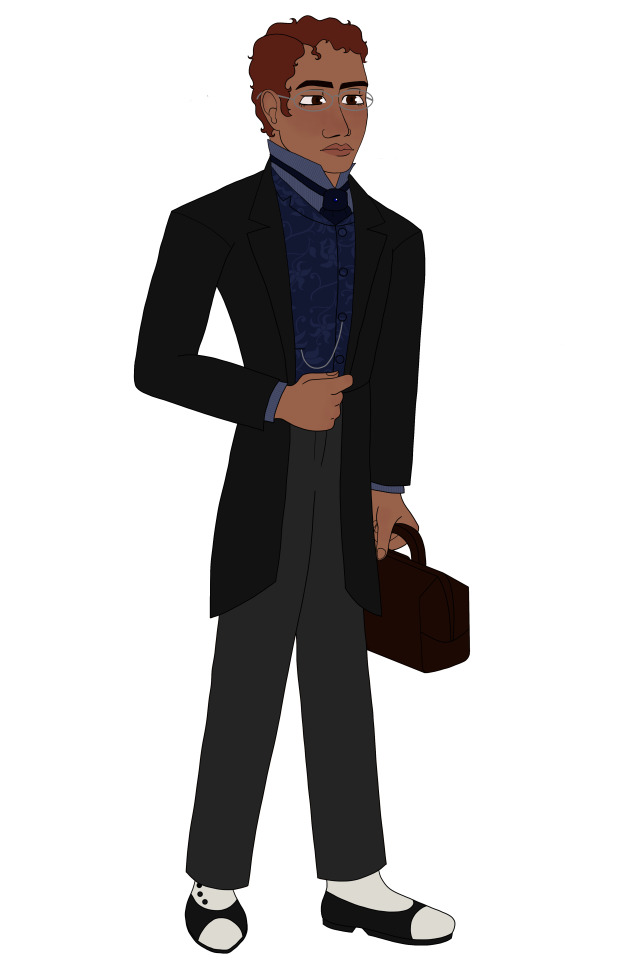
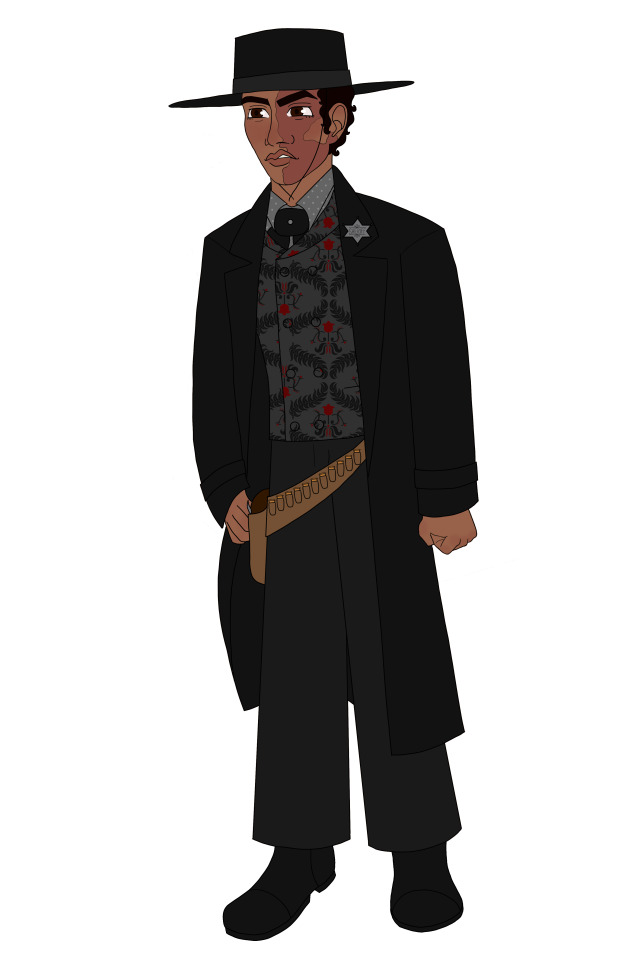
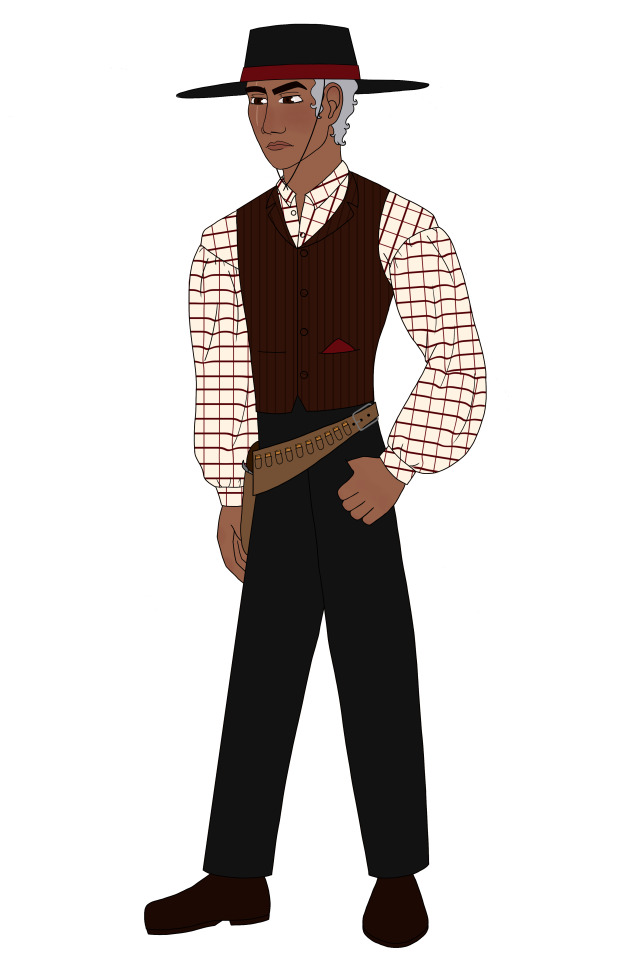

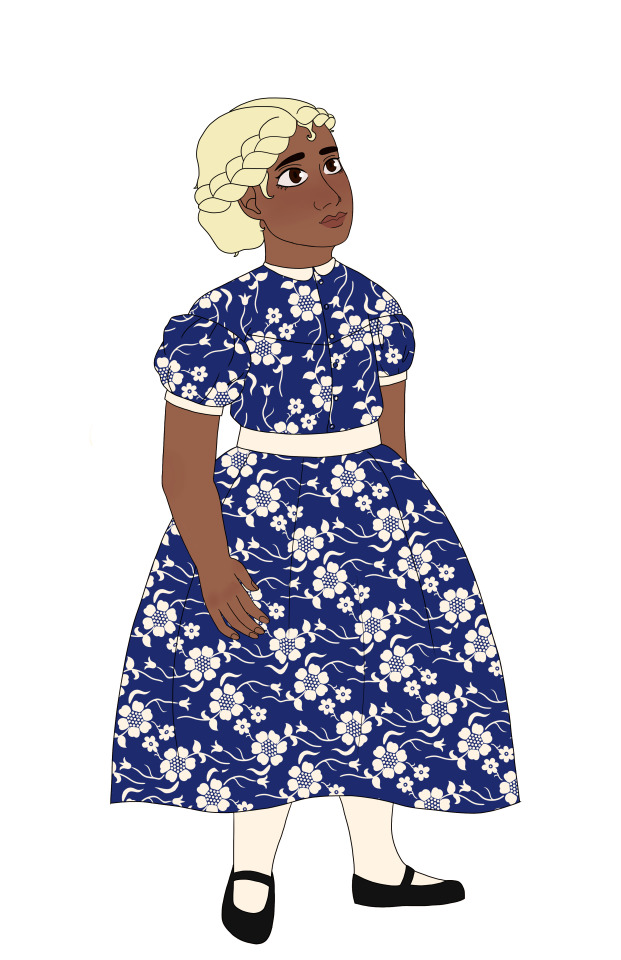
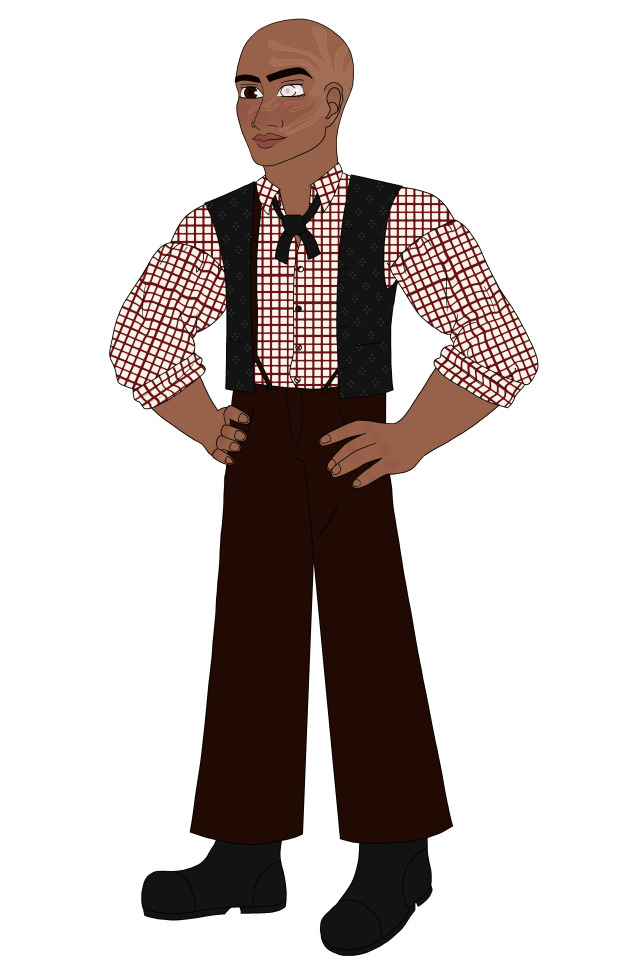
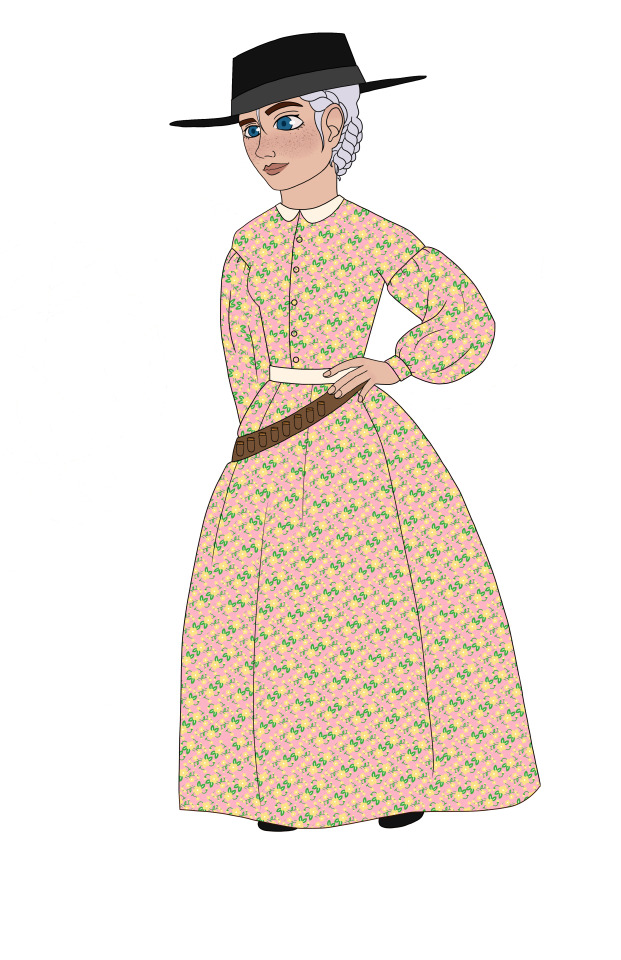
SO I absolutely love historical dress, and I saw The Bad Batch western AU by @hellothere-generalangsty , so I had to do this. (I’m also going to tag @mintywriteswritings because I first found the AU through her and she writes beautiful fics for it) Our view of the wild west is very 1950′s Hollywood, which is fine, but I just wanted to design some historically accurate costumes. (I made one for myself too because I wanted to design another dress) I’ve been working on this for at least a month? I think? So here’s the (mostly) historically accurate Bad Batch. If you want to read more about my decisions or research, you want to learn more about historical accuracy for your fics, or just think historical fashion is fun, please keep reading under the cut.
Our time period here is the late 1860′s.
I want to emphasize that this is DAY WEAR. This is what you’d be wearing around town or at work or at home. Evening wear is an entirely different beast altogether.
I guess I’ll start with Tech. Tech is the most fashionable. He’s a city boy and a doctor, and has access to more expensive fabrics, as well as knowing more about what’s trending. Everyone else is a year or two behind the fashion because it takes a while for the fashion to move out west.
His frock coat is very in fashion.
Working class people tried to stay on the fashions just as much as wealthier people, they just used what they had, typically adapting garments they already had to suit the new styles.
Lower class and working class people typically had maybe 4? outfits total. Two to switch out day to day, a “Sunday Best” to wear to church, and then something to wear to fancy occasions like dances and weddings (evening wear). Tech, being a bit wealthier, may have a few more than that.
Undergarments were changed everyday and washed more frequently than the outer clothing. Typically the outer clothing isn’t touching your skin much so that it didn’t get sweaty and didn’t have to be washed often. (washing=more wear and tear on the clothes) Aprons were worn during work to also keep the clothing from getting soiled.
The dropped shoulder seam and bishop sleeve was the go-to for both men and women.
Men would not go any where with at least a vest over their shirt if there were to be any women present (except their wife). Just the button up shirt is essentially like being in your underwear.
Likewise, women would never, EVER, have their hair down around men (except their husband.)
Woman’s hair was always parted in the middle (side part was only for men) and pulled into an up-do low on the head.
I had to cut Hunter’s hair, because long hair for men was only found on Confederates during this time and I just could not stand for that.
The modern cowboy hat didn’t exist yet. The hat here is “The Boss of the Plains.” It had only recently been created but was an instant hit. If the time period was any earlier than the 1860′s your cowboys would’ve been wearing a bowler hat.
If you are a woman, YOU ARE WEARING A DRESS. If you wore menswear at this time, you would get laughed out of town. No trousers. Not until at least the 1910′s did it become somewhat acceptable for women to wear pants at all. Yes, even while riding a horse, which means...
WOMEN ALWAYS RODE SIDE SADDLE. No exceptions. Not in the 1860′s.
WOMEN ARE WEARING CORSETS. YES, EVEN WORKING IN THE FIELDS. Corsets have been given a bad name by modern media, don’t fall for it. I could go on about corsets for hours if you let me. They did not restrict your movement or breathing. They weren’t laced tightly. They just provided structure and essentially functioned as the precursor to the bra. If it is before 1920, you are wearing a corset.
This is a mistake that’s made a lot, but you wore a chemise under your corset. Your corset does not touch your bare skin.
Women wore crinolines (kind of like a hoop skirt) that were slightly fuller at the back (getting ready for the bustle that was popular in the 1870′s). This is likely the only undergarment that MIGHT have been shed during hard labor.
Working women still wore full length dresses, only hemmed maybe an inch shorter for ease of movement.
Clothes for children were just smaller versions of adult clothes, really.
Young boys (like under the age of 6?) wore dresses until they were older.
Women and girls would’ve worn bonnets, but I think bonnets are fugly so I didn’t draw any.
There were just so, SO many amputations performed during the Civil War that the entire culture around disability changed. There was better accessibility and technology for disabled people than ever before.
I don’t think Tech would let Echo look shabby so he always makes sure that Echo is dressed appropriately.
I gave Echo a frock coat like Tech’s to mimic his kama, but then I put him in a wheelchair so you can’t even see it.
For shirts, dresses, and vests, they didn’t really do solid fabrics during this period. The more elaborate the pattern the better.
A shaved head on both men and women indicated that they were either ill or were recently ill (consumption, anyone?)
I based Hunter’s birthmark on my irl uncle Doug, who was a real cowboy.
I allowed hair-dye and bleach to exist because it helps keep the characters recognizable and also because I can.
The funnest part of this project was probably designing the patterns on the clothes.
My favorite design is probably Tech.
Menswear is kind of boring. It doesn’t change much after the Regency period. It was very tedious reading about the varying width of lapels in the 1800′s.
Overall, this period of fashion is not my favorite. This project made me yearn for the vastly superior 1890′s-1910′s era. But I still had a lot of fun.
If you still have questions feel free to ask. I don’t have a degree in historical fashion or anything, but I did hella research for this and if I know the answer to your question I’m happy to help.
45 notes
·
View notes
Text
BLOGTOBER 10/30-10/31 (IT AIN’T OVER YET!): DISCONNECTED (1984) + PERSONAL SHOPPER
One night on a double date at a local night club, sweet, shy Alicia (Frances Raines) tries to tell the foursome about a strange experience she has had that day: She let an old man into her apartment to use her telephone, but he mysteriously vanished before she could let him back out. Her friends are not interested. Her boyfriend Mark (director Gorman Bechard), a smug radio DJ, dismisses her story as some sort of misunderstanding, and her vivacious twin Barbara Ann (Raines) cuts her off entirely by flirting openly with Mark, insinuating that she was with him that afternoon. This is the last straw in what appears to be an ongoing problem for Alicia. Outside in Mark's car, she refuses to accept his denial of sleeping with Barbara Ann, beginning an agonizing breakup process that drags out for days. Even at her job, Alicia can't seem to establish any personal boundaries; an awkward young stranger called Franklin (Mark Walker) visits during her shift at the video store, and reveals that he doesn't even own a tape player--he just found out who she was and where she worked from other club patrons the previous evening. Alicia rebuffs his unseemly advances at first, but with the insulting drama still festering between Mark and her manipulative sister, loneliness sets in. She could use some company to help insulate her anyway, since their town is plagued by a killer of young women...and stranger still, Alicia's telephone has taken on a mind of its own, broadcasting otherworldly sounds into her apartment, slowly driving her mad. She has a difficult decision to make about who or what she can trust, but it may be that there is no correct choice.
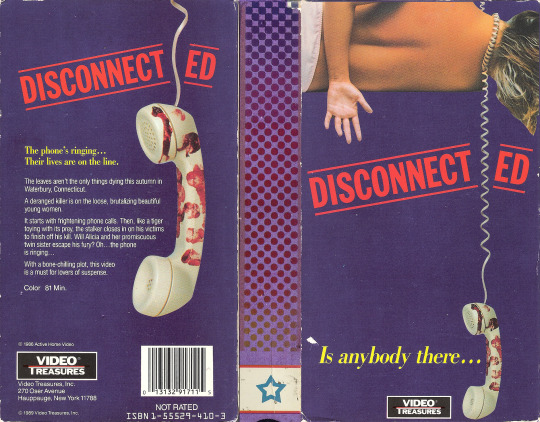
Gorman Bechard's atmospheric 1984 oddity DISCONNECTED follows in the footsteps of CARNIVAL OF LOST SOULS, joining a subset of subdued psychological thrillers about women alone. In Herk Harvey's 1962 classic, Candace Hilligoss plays Mary Henry, a withdrawn young woman who moves far from home after a traumatic accident. Where she hoped to find peace, she is stalked by a spectral male figure, and receives no help from the locals, who are all suspicious or covetous of her. The boundary between the living and the dead begins to dissolve, mirroring her increasingly ambivalent relationships with other human beings. Mary is torn between her longing for solitude and her fear of impending doom, having to choose between an intrusive suitor, and being left alone with her cadaverous stalker. Mary's unforgettable journey through her desolate surroundings, her isolation interrupted only by enemies both open and hidden, describes an experience that many female viewers have found familiar. Social life portends various threats--judgmental elders who pick at your morals and appearance, jealous females, emotionally and physically violent males--while solitude offers obliterating blankness, like a desert whose expansive monotony renders meaningless the defining lines of past, future, and self. In modern times, this distinctly female experience is complicated by the evolution of personal communication media. The telephone in particular--which has been historically and rather demeaningly associated with girls--is both a channel through which to reach out and touch someone, and an opening through which unwanted attention can insinuate itself into our lives. Two years ago, I saw DISCONNECTED--a loopy microbudget slasher movie from Waterbury, Connecticut--and one of my first thoughts was that it was somehow just like PERSONAL SHOPPER, Olivier Assayas' heady cyberpunk-flavored thriller from 2016, in which a servant to the stars receives threatening text messages from someone who may or may not be among the living. I've been trying to put the two together in writing ever since.

In PERSONAL SHOPPER, Kristen Stewart plays introverted American Maureen, the virtual slave of supermodel Kyra (Nora von Waldstatten). Maureen is a stranger in a strange land, travelling relentlessly around Europe to procure garments and jewels for her boss in Paris, and on her personal time, conducting a psychic survey of her late brother Lewis's mansion. Twin mediums Maureen and Lewis promised one another that whoever died first would send the other a sign from across the divide; Maureen has been waiting since his untimely heart attack for him to hold up his end of the bargain. So far she has only witnessed some scattered poltergeitic activity, along with the manifestation of a ferocious, unknown female specter, but the clock is ticking, as the manse is mid-sale to Lewis’ friends. Furthermore, it is her employment with the tyrannical Kyra that allows her to stay in Paris and wait for a sign from Lewis, so Maureen’s freedom also is dependent on the resolution of this situation. When she meets Kyra's arrogant lover Ingo (Lars Eidinger), he inappropriately insists that he can get her a better job elsewhere, but she explains that she can't change her life until she has closure with her brother. Shortly after this unpleasant encounter, Maureen begins to receive intrusive texts from an unknown caller. Due to her unusual relationship to the dead, she can't be sure if her new stalker is a part of her world, or not.

PERSONAL SHOPPER has very much the flavor of William Gibson’s speculative fiction novel Pattern Recognition, in "cool hunter” Cayce Pollard has the extra-sensory ability to detect what new designs will become popular next. Cayce’s special power manifests as a crippling allergy, and so she tries to remain in timeless, fashion-neutral clothes and settings whenever possible. Psychic Maureen feels a similar kind of existential ambivalence toward the super luxe materials she excels at curating for her client.
Maureen spends much of her screen time alone. Most of her personal contacts are with salespeople; she virtually never sees Kyra in person, and her boyfriend Gary (Ty Olwin) lives in Oman, which may as well be another world. Her chief relationship is to her dead brother, who is literally in another world, and who responds with frustrating ambiguity to her pleas for a clear message, even as his mansion rumbles with unexplainable activity. This void of connection seems somehow related to Maureen's tenuous sense of personal identity. With no close connections, she cannot accurately detect her own contours. Maureen is totally sublimated into Kyra's life, simply an extremity that grasps for whatever Kyra needs. At the same time, she is subject to Lewis's will, unable to make any moves--even to protect herself--until her late brother deigns to give her peace. Maureen's identity is entirely determined by other people, including the mystery caller who lures her into a confessional conversation with him. Although this third figure is the most predatory of them all, he is also the one who teases out the threads of Maureen's fraying individuality. When she admits to trying on Kyra's clothing, just because she's not allowed to, he entices her to stay in Kyra's bed while she's away, further feeling out her own limits. This is the only way Maureen can establish a self that is independent of the context of others: by violating the taboos established by those others. The rule-breaking method of finding oneself is an integral part of the human condition, as explained by media theorist Marshall McLuhan in a discussion of the self in the age of social media:
"Yes, all forms of violence are quests for identity. When you live out on the frontier, you have no identity. You are a nobody. Therefore, you get very tough. You have to prove that you are somebody. So you become very violent. Identity is always accompanied by violence. This seems paradoxical to you? Ordinary people find the need for violence as they lose their identities. It is only the threat to people’s identity that makes them violent. Terrorists, hijackers - these are people minus identity. They are determined to make it somehow, to get coverage, to get noticed."
By breaking Kyra's rules just on principle, Maureen moves toward self-actualization. Unfortunately, this comes at a cost, as the mystery caller who encourages this process wants to possess her just as much as Kyra and Lewis already do.
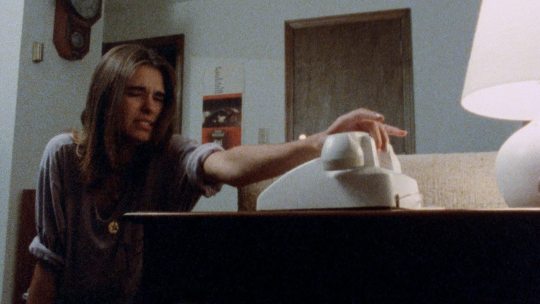
Maureen's phone has become a ouija board-like portal to another plane, through which alien forces can cross over and affect our fate. In DISCONNECTED, Alicia suffers from a similar problem. Alicia's social isolation, and the increasingly meaningless division between life and death for her, is underlined by the fact that she lives on the edge of a cemetery. Her phone is her connection to the world--to the ambiguous Franklin, to her sister who she can neither accept nor reject, to Mark who she can't quite leave behind. She can't get rid of this device, even when it starts to ring almost constantly, with a horrifying, vaguely vocal-sounding barrage of electronic noise on the other end. As in PERSONAL SHOPPER, Alicia is largely seen alone, pacing in her apartment, wandering teary-eyed in the depopulated streets of Waterbury, and eyeing her phone with nervous anticipation. She finds herself living out an appalling version of the classic Twilight Zone episode "Night Call," in which Elva, an old widow longing for her late husband, is harassed by increasingly disturbing phone calls from beyond the grave. Like Elva and Maureen, Alicia also suffers from the conflation of companionship and otherworldly threat: Just as she doesn't understand the source of the distorted calls, she also doesn't know that Franklin--her potential savior from this dark chapter of her life--is a serial murderer, planning to have her for his next victim. When Barbara Ann makes a move on him, perpetuating the cycle of sororal abuse that started with Mark, Franklin kills her instead, removing one of Alicia’s few contacts with the rest of humanity.
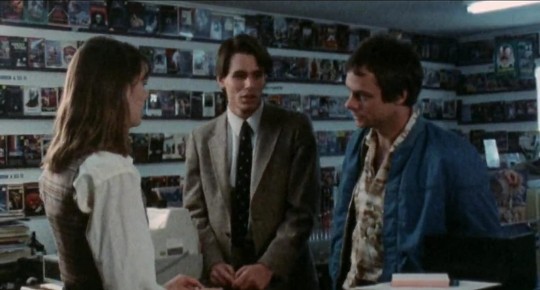
BTW, even though Alicia eventually takes a liking to Franklin (center), her experience at the video store--here, trapped between an aggressive suitor and a similarly aggressive porn consumer--forms the most realistic portrait of retail hell for girls that I have ever seen in my life. When Franklin first arrives, announcing that a) the movies there aren’t good enough for his refined tastes, b) he doesn’t even own a video player, and c) he’s only there because he’s stalked Alicia from her local watering hole, his intensely condescending attitude and presupposing come-ons gave me a hardcore PTSD reaction from the many years I spent behind the counter of a comic book store. Yuck.
While Alicia doesn't understand what is happening until it's almost too late, Maureen's situation escalates horrifically when her latest jewelry delivery brings her face to face with Kyra's mutilated corpse. As she reels from this gruesome sight, she also detects a malevolent presence vibrating deeper in the apartment that sends her fleeing in terror. When she goes to the police, her mystery caller suddenly becomes more sinister, demanding to know whether she has told the cops about him. In short order, the caller tries to blackmail her into meeting him in a hotel room, but this climactic union is circumvented by the police: It was Ingo guiding Maureen's journey of self-discovery, and Ingo who killed Kyra. The revelation is enormously painful, not because Ingo is so important, but because he managed to victimize Maureen using her most uniquely personal characteristic: her relationship to the supernatural. She believed that something personally significant was happening to her, according to her special understanding of the world, but she was merely being preyed upon by a violent narcissist. Her profound belief in her own paranormal sensitivity--the one thing she is sure of, that distinguishes her from others--is what made her vulnerable to the insistent texts begin with: She wondered if it was Lewis texting her. Ingo exploits Maureen's convictions about herself to perpetrate a deadly fraud, leaving her violated and humiliated. Even though we witness the presence of an unseen entity (Lewis? Kyra?) moving through the hotel, perhaps influencing Ingo's capture, Maureen is left to suffer for being gullible and vulnerable, to mourn her own privacy.

Of course, Maureen's journey is not over yet, and Alicia receives a similar shock with a full half an hour to go in DISCONNECTED. She is rescued by her own screams on her last date with Franklin, as the sounds of their skirmish draw the police to his apartment where they summarily execute Alicia's would-be killer. Now she is left with almost no worldly connections at all--save for the malign presence that keeps calling her phone, blasting her with waves of mind-melting noise. To make matters worse, there seems to be a new victim in the rash of murders previously tied to the late Franklin. Alicia plunges into a spiral of nihilistic despair, in which her closest relationship is with her conniving ex--mediated by the phone, and by his radio show where he dedicates songs to her--second only to the mystery caller who dials her number several times an hour. Craving a human connection, Alicia eventually relents and lets Mark take her out again, and things seem to be on the upswing...until Alicia returns home to find that something worse than electronic fuzz has entered her home, to put an end to her misery. We don't share her final vision, but we do see the mysterious old man (William Roberts) from the beginning of the movie, the fellow she let in to use her telephone, strolling into the cemetery--presumably, from whence he came.
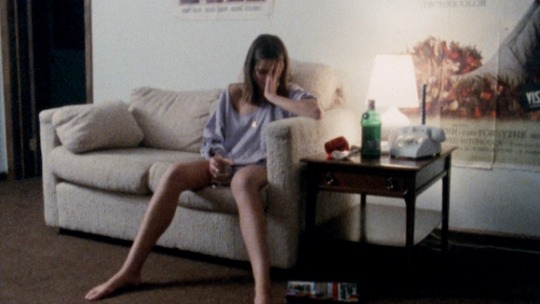
Like Alicia in the aftermath of Franklin’s death, Maureen also has to find a new way to survive after an episode of shocking violence. For Maureen, the only way through is out. As she prepares to leave Lewis' mansion, she encounters his widow's new beau, Erwin (Anders Danielsen Lie). This encounter crystalizes the movie's themes regarding time. Early in PERSONAL SHOPPER, Maureen is turned on to the visionary paintings of Hilma af Klint, a 19th century painter who claimed that she made her art at the behest of ghosts. She mandated that her work only be revealed to the public after her death, creating a communication channel between the deep past and the distant future. Maureen argues with her doctor about the future; he insists that her brother's heart attack was purely anomalous, but Maureen sees no reason why the same thing couldn't happen to her. She sees no future for herself, and is chained to the past by the ghost of her brother, who withholds the spiritual message that would allow her to move on. Lewis thought a lot about the future, Maureen remarks cynically to her doctor, despite the fact that he was ultimately deprived of one. Later, Lewis' widow Lara (Sigrid Bouaziz) explains that she feels the future is in flux and unknowable--a desirable quality, in her book--and so she is moving on to be with Erwin. So, when Maureen encounters Erwin on her final night in Paris, they have a pointed conversation about the shackles of the past and the fossilizing force of guilt on one's life. Lewis's ghost cruelly teases Maureen at the end of the scene, demanding attention but refusing to reveal himself. With nothing to show for her devotion to her brother, she flees Europe.
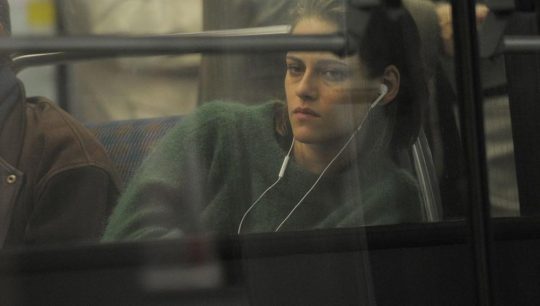
In both DISCONNECTED and PERSONAL SHOPPER, the archetype of the twins is used to describe opposing states of being, and the threat of having one’s life usurped by another version of oneself. Alicia's sister Barbara Ann is lively, sensuous, and self-serving: everything that Alicia is unable to be, and the consumer of everything Alicia wants for herself. With her unrealistic desires for honesty and compassion, Alicia is the more death-oriented twin: cut off from social life, deprived of pleasure by more ambitious people, and vulnerable to parasitic attacks from both sides of the mortal veil. Alicia even dreams of Barbara Ann murdering her, and literally taking her place in bed with Mark. Maureen's twin Lewis is described by his survivors as passionate and living on the strength of his own convictions; Although Maureen still lives, she is inert, somehow chained to him, slavishly waiting for him to grant her release, though he is content to torment and manipulate her. The protagonists of both films are subjugated to these duplicates who refuse to stay on their side.

Maureen flees to Oman to reunite with her boyfriend Gary--heretofore only a pixelated image in a video chat who begs her to give up her commitment to the kingdom of death, insisting that only the material world exists and is waiting to embrace her. Of course, when Maureen arrives in Gary's placid and spartan world at what may as well be the end of the universe, her problems have followed her. We will never see Gary in the flesh; he has left a written note of welcome for Maureen, which she reads just as she detects a supernatural presence in his dwelling. Hoping against hope that Lewis is finally reaching out to her, she asks out loud: “Is it you? Are you at peace? Are you not at peace? ...Or is it just me?” And, hauntingly, she hears a ghostly knock in the affirmative for every question.
The ambiguity of this ending has troubled some viewers, although multiple interpretations present themselves which are not mutually exclusive. In the most literal sense, Maureen can be seen as a terminally frustrated Carrie White-like figure who causes material disturbances with the power of her own inner turmoil. The paranormal phenomena she perceives are, indeed, “just her”. On a more metaphorical level, we can see that Maureen is haunted by her own grief, over her brother, and also over her failure to forge a life of her own. In her mind, her brother was a superior life force to which she remains subservient; she identified herself entirely as a receiver for his message, and without his active participation in her life, she loses all sense of purpose. She scrutinizes ghostly disturbances and the spiritual conduit of the telephone to inform her place in the world. Without an internal, independent reason for being, people like herself, and like Alicia, are forever haunted.

#blogtober#2020#disconnected#disconnected 1984#personal shopper#olivier assayas#frances raines#kristen stewart#lars eidinger#sigrid bouaziz#mark walker#anders danielsen lie#ty olwin#horror#supernatural#viral media#phone horror#slasher#mystery#ghost#haunted house#gorman bechard
18 notes
·
View notes
Text
From Bridgerton to Hamilton: A History of Color-Conscious Casting in Period Drama
https://ift.tt/2IQI6Ak
Note: This Bridgerton article contains no book or series plot spoilers.
Bridgerton is a unique mix of Shonda Rhimes’ dedication to Black representation on American television and the British period drama tradition. White critics may dismiss this trend as unnecessary “pandering” to Black and POC viewers, but the number of productions designed around reforming all white-casting has increased over the past 10 years—and has only added to the success of the genre. The number one reason driving demand for diverse period dramas is from Black and POC fans of the genre. The impact of seeing an actor that looks like you can’t be measured in ratings or clicks online. Despite facing years of content and fandom overtly or covertly claiming that the universal themes in period dramas are not “for us”; the tide is starting to turn as fans use social media and the power of ratings to ask for more representation.
A quick overview of recent Regency England-set productions leaves much to be desired. Although the 2018 Amazon Prime/ITV miniseries and the 2005 movie adaptations of Vanity Fair left in West Indian and Jewish heiress Miss Schwarz, she is one of many supporting characters. PBS/ITV’s Sanditon, on the one hand, improved representation by prominently featuring Georgiana Lambe. However, her story was a huge disappointment to Black and POC fans who expected her plotline to end happily or at least have her conflicts resolved.
There have been three paths traditionally towards increasing diversity in period dramas: 1) blind casting (also called racebending), where Black and POC actors play traditionally white characters adding original Black characters to existing fictional works, and 2) Own Voices, where Black and POC writers share their own stories. These two are not mutually exclusive, but, in the world of British period drama, the former is more frequently used, as the bedrock of the genre is adapting existing novels and plays by white authors.
The theoretical framework for inclusive casting begins in the world of staging period drama at the theater. In Shakespeare’s day, men played women’s roles as women were not allowed to appear on stage. The genre evolved in later centuries to allow women to appear on stage, but the tradition of having actors who didn’t match the original descriptions remained. This is even true of his history plays where real women royalty were characters. Ira Aldridge in the 1840s was the first Black actor in Britain to play traditionally white roles on stage. Later on, in the 19th century, several stage adaptations of Jane Austen’s works had all-women casts.
Fast forward to 2015, when Lin-Manuel Miranda in Hamilton redefined what it meant to cast inclusively in modern period dramas by using actors descended from slavery and colonialism to play the Founding Fathers. Every aspect of the musical was designed to reframe the existing narrative of early American history. The costume design also reflected the identities of the actor by featuring braids, locs, and textured hairstyles over 18th century white hairstyles. Rap lyrics conveyed to the audience the names, dates, and other descriptions of the Revolutionary War. The old adage that someone must “look the part” to play a biographical role was thrown out the window.
Hamilton proved that many of the old excuses used to sideline diverse period dramas no longer held to be true. Millions of white people listened to the cast album, brought tickets, or streamed the movie on Disney+. UK theater patrons flocked to the West End cast of Hamilton, as well, before the pandemic. Memes, parodies, and more on social media proved that white audiences can conceptualize historical figures as fictional characters while also knowing the real figures looked and acted quite differently. Fans of the show pushed Ron Chernow’s biography back onto the bestseller lists as they wanted to read what really happened.
The first clear impact the show had on the genre of British period drama comes from a mystery. Daisy Coulam, Grantchester’s head screenwriter, cited reading an interview with Miranda as the inspiration behind the exit plotline for James Norton’s character Sidney Chambers. UK crime dramas For those unfamiliar with the series, Grantchester is a mystery procedural based on a series of books about a 1950s crime-solving Anglican vicar by James Runcie. Norton’s exit plotline in Season 4 generated an original to the show character named Violet who was the daughter of a visiting African-American preacher. Violet was an original character who forced the audience to consider that the US civil rights movement indeed reached their treasured vision of the lily-white British countryside. Coulam already laid the groundwork for Violet in earlier seasons by abandoning large sections of the original novel timeline and but keeping the case of the week focused on addressing 1950’s social issues. Fans heavily criticized Coulam’s writing for style and pacing, but her imagination clearly indicates that Hamilton’s proven formula for disrupting established historical aesthetics can just as easily be applied to fictional depictions of the UK’s past as blind casting a biography-based series or depicting real figures of Black British history.
Other period dramas released in recent years share traces of Hamilton’s impact but in a more thematic and less direct different way. Some shows turned real Black British figures into fictional characters. Lina (Stephanie Levi-John) and Oviedo (Aaron Cobham) on The Spanish Princess are composites of Catherine of Aragon’s servants and several famous Black Tudors. Catherine “Kitty” Despard (Kerri McClean) in Poldark Season 5 was a forgotten Black British figure added in to expand the world outlined in the novels. Victoria featured Ira Aldridge (Ashley Zhangazha) mentioned earlier, plus spotlighted the Queen’s adopted daughter Sarah-Forbes Bonetta and Cuffay (C.J. Beckford) as the leader of the proto-socialist Chartists. Lucille Anderson (Leonie Elliott) on Call the Midwife was not mentioned in the original memoirs, but she was added to represent the Caribbean nurses from the Windrush Generation of UK immigrants.
Racebent casting also increased. Dev Patel’s role as the title character in the movie The Personal History of David Copperfield proved that Dickens adaptations could indeed include POC casts without changing the fundamental plot and message. PBS/BBC’s Les Miserables miniseries also extended the Broadway tradition of casting Black actors in traditionally white coded classic literature characters. Hulu’s The Great featured Sacha Dhawan and several Black actors as Russian nobility, politicians, and courtiers.
All of these series, however, carefully attempted to stay grounded in recreating the original source material or invested in faithfully replicating the era they were set in. Bridgerton radically expands upon Hamilton’s formula by divorcing inclusive casting from any desire to accurately recreate historical events, eras, or figures. Romance, fantasy, and social/familial drama are universal themes that don’t depend on having a white-dominant vision of society. Quinn’s original novel series sparingly referred to historical events during the Regency Era. Her focus was on creating a world where the most important events were balls and weddings. More Dukes and other holders of inherited titles exist in her vision of the Ton (the most elite members of Regency society) than in reality. Historians would likely dispute her characterization of the elite social season as well. Characters’ internal dialogue is in modern English peppered with regional accents and slang. They rarely lampshade or criticize the way of society beyond their romantic desires and family obligations. Readers see the physical intimacy on the page Austen never mentioned. This literary environment is ripe for inclusive casting on screen.
The most critical flip in characterization is Simon, Duke of Hastings (Regé-Jean Page). His character is the romantic hero of the first book in the series The Duke and I and is the character that set fan expectations high for future novels. Simon having visibly African features and yet being an object of desire is incredibly subversive in a genre where white beauty standards dominate hetero and homosexual fiction.
Lady Danbury (Adjoa Andoh), Simon’s godmother, is an elder stateswoman and a twist on the battle-ax aunt trope popular in period dramas. She isn’t as caustic and insulting as some other famous widows and spinsters but she commands authority and a mansion filled with people to perform all the hard labor. Lady Danbury is even implied to be slightly higher in status than her white counterparts with children of marrying age Lady Violet Bridgerton (Ruth Gemmell) and Lady Portia Featherington (Polly Walker).
Queen Charlotte (Golda Rosheuve) being played by a biracial woman is actually a subtle Easter Egg to existing history debates. Many have debated if her portraits were airbrushed to disguise African features. A few years ago, a documentary established her African ancestry is via the Portuguese royals. All of her scenes involve petting her Pomeranian, demanding to know the latest gossip, and manipulating the gentry into doing her bidding.
The miniseries doesn’t end the racial diversity with those at the highest social rank or even at the lower orders of domestic servants. Marina Thompson (Ruby Barker) is a cousin of the Featheringtons and represents the “poor relation” character popular in stories based on the British gentry. A Black modiste (dressmaker) trained in French fashion makes all of the dresses the characters wear. Will Mondrich (Martins Imhangbe) is a boxer, likely a reference to former slave turned bare-knuckle boxer Bill Richmond. Alongside the characters with plot lines viewers follow, there is a conscious effort to hire Black and POC extras to fill in crowd scenes at balls, park scenes, and other public events. The viewer sees people who look like themselves in every class level of society and can feel like they too can become part of their world.
Read more
TV
How Bridgerton Can Avoid Outlander’s Mistakes
By Amanda-Rae Prescott
Books
Bridgerton: Cast Announced for Shonda Rhimes Netflix Series
By Alec Bojalad
Attire is a critical part of upholding the fantasy and cultural diversity Bridgerton and also in communicating to the audience the series isn’t your aunt’s neutral tone Austen adaptation. Marina and Lady Danbury would never be caught dead in a plain white muslin frock. All of the popular Regency hairstyles for women have been modified and reworked for natural textured hair, braids, and locs. Some of the Black male extras even have modern African hairstyles left in tact. The only Black characters who wear the traditional white wigs are older men or servants in full formal uniform. Queen Charlotte’s Black courtiers and servants wear a mixture of extravagant 1770s and 1780s attire and Regency court wear to create a physical separation between them and the rest of the ensemble cast. These style decisions are right out of the playbook of Still Star-Crossed, Shondaland’s first foray into period drama. Although that series took place in 1300’s Italy, the priority was on blending fantasy and Black fashion aesthetics over catering to white costume enthusiasts and reenactors.
In the world of Bridgerton, slavery and colonialism are directly or indirectly referenced exceedingly sparingly. One reference is to Lord Dunmore’s army of emancipated and runaway slaves during the Revolutionary War proclamation. (Hercules Mulligan’s Black troops referenced in “Stay Alive” is the Patriot equivalent of Dunmore’s forces). These sparing hints make it clear to the viewers that class, family, and personal family drama is the root cause of joy and pain in this series.
Since Bridgerton is completely ignoring the physical descriptions of the characters in many cases, the set design carries the bulk of the attention to historical detail. The series hired Dr. Hannah Greig as a historical advisor to ensure these details were as close to 1813 as possible. Greig has previously acted as a consultant to the Sanditon, Poldark, and The Duchess cast and crew is likely where the Easter Eggs in character references come from. Lavish mansions and castles and the more humble spaces ground the fantastical plot details in historical reality. Several previous period dramas have recreated the Vauxhall Pleasure Gardens, but these scenes in the miniseries are elevated to the next level thanks to Netflix’s budget.
Read more
TV
Noughts + Crosses: Why You Should Watch This Afrofuturist Alternate History Romance
By Amanda-Rae Prescott
TV
World on Fire Returns People of Color to the Dunkirk Narrative
By Amanda-Rae Prescott
The success of Bridgerton applying color-conscious casting to a fantasy/romance series has implications far beyond potential future seasons. Studios especially those in the UK have been hesitant to utilize recent historical romance books for screen adaptations. Modern historical fiction by Black and POC authors (called Own Voices fiction) which is crucial in the fight for increased representation. Novelists such as Beverly Jenkins, Courtney Milan, and Alyssa Cole have written romances set in the Regency and other eras of American and British History that can easily be transformed into movies and miniseries. Some of these novels recreate existing history while others lean into escapist fantasy. The ultimate goal in period drama representation is for Black and POC creatives to tell their own stories covering all the ranges of emotion, not just historical trauma.
cnx.cmd.push(function() { cnx({ playerId: "106e33c0-3911-473c-b599-b1426db57530", }).render("0270c398a82f44f49c23c16122516796"); });
Critics can keep attacking period dramas for being “too woke” (a term that was stolen from anti-racism activists) for remembering that white people aren’t the only inhabitants of the British Isles and America, but series like Bridgerton are here to stay. Black and POC viewers and readers of period drama and romance fiction always existed, and viewership will only grow if more inclusive period romance projects are greenlit in the future.
The post From Bridgerton to Hamilton: A History of Color-Conscious Casting in Period Drama appeared first on Den of Geek.
from Den of Geek https://ift.tt/3mjLv8v
10 notes
·
View notes
Note
Hi! Im writing a story that has to mix fantasy and reality, Ive always been interested in folklore, cultures, and beliefs of other people. All of these things are involved in my story, I wanted to add in a character that is Native American (Her name is Rosalie), I'm on the fence because I don't want to touch something that I shouldn't. How should I go about this? Should I change her ethnicity, Should I in someway make it my own? Or how should I write it or should I write about something else.
This is tricky. And the answer is going to be really long. Sorry.
I want to make it clear that I am not myself in any way a representative of Native people or claiming to be one. I’m just a white lady who grew up near the reservation and have had maybe more interactions with Native American cultures than a lot of people. But at the end of the day, I’d defer judgment to people closer to the people being specifically affected.
So, with that disclaimer out of the way. Here’s the thing. I’m not here to tell anybody what they should or should not write about. But I can hopefully give you some stuff to think about that will help you decide.
Thing One: “Native American” is not a monoculture. There are 574 tribes federally recognized by the U.S. government. They are all culturally distinct. They each have their own histories, mythology, religion, food, lifestyle, and so forth. So before you go creating any Native OC, you’re gonna want to narrow that down to a tribal affiliation.
You can do this one of two ways. You can choose a geographic location and then look for a tribe who lives in that area, or you can choose a tribe and then root them in that geographic location. Of course, a Lakota Sioux could live in New York, but she wouldn’t be from New York, you feel me?
Writing about “Native Americans” without understanding their tribal affiliation and history is like writing about “Europeans” as if Italians and Russians and Greeks and Germans were all the same.
Thing Two: If you’re going to be talking about mythology/folklore, you need to do your research while also recognizing that a lot of the most accurate and authentic information is not going to be accessible to you.
A lot of Native cultures are “closed” cultures in the sense that they’re not going to teach sacred knowledge and rituals to outsiders. They’re just not. It’s none of your business. They’re not hiding this information from you because they want to be greedy, they’re hiding it because until 1978 it was illegal for them to practice their religion in public in a lot of the country. A lot of things from Native cultures have been erased forever or diluted by outside influences.
So this means that if you’re writing a character whose life includes or is influenced by traditional culture, there are some things you won’t be able to portray accurately. And I personally think it would be disrespectful to just make something up, especially if you don’t make it extremely clear that you’re making it up.
For an example of how this could work: The film Dance Me Outside is a really great mystery-thriller set on a reservation, and I heartily recommend it. But there’s one scene where one of the characters has married a white guy. She brings him home to her family and, for plot reasons, needs him to be out of her hair for a bit. So she sends him out with some of her male relatives to keep him occupied. They decide it would be hilarious to do a “naming ceremony” to give him an “Indian Name.” It’s very clear in the narrative that they’re making this up as they go along -- they are creating what they think he thinks a naming ceremony would look like, and he’s gullible enough to go along with it because he’s eager to please (and at this point very drunk). The scene is very funny and advances the plot and develops some characterization without ever actually revealing any secret/sacred knowledge.
But in general? If something is sacred to a tribe? You don’t get to fuck around with it. You don’t get to put your own fresh spin on it or just make up stuff that “sounds” authentic. Because...
Thing Three: You will encounter a TON of fake or inaccurate information out there. Just, a ton. Because here’s the thing. White folks didn’t just commit genocide against Native people. It wasn’t enough to destroy their people and their culture. White folks have a really long history with appropriating their culture.
So the situation is that you get a group of people whose ancestors were actively hunted like animals (there were bounties for scalps!), sent to forced re-education camps where they were frequently abused and scrubbed of their culture and language, and who were not allowed to practice their religion under threat of law. And at the same time, aspects of those religions and cultures -- that the people who made them cannot practice! -- are taken and absorbed into pop culture.
Yeah. It’s shitty.
So when you’re researching, you need to be absolutely certain that your sources are coming from actual Native Americans from the tribe you want to write about and not from white folks who think some aspect of their culture is neat. Because, personally, I feel like cultural appropriation -- in the context of Native Americans -- is continuing to perpetuate genocide, and that feels icky.
Thing Four: Modern Natives =/= Historical Natives.
There is this....weird, colonialist tendency to imagine Native Americans as...living fossils, or quaint backwards people who live in old-fashioned ways, or as a thing that used to exist but not anymore. I get the impression talking to a lot of people that they think Native Americans stopped existing in the Wild West days. Like “Indian” is a category in their head alongside “Cowboy” and “Samurai” and “Pirate” or whatever.
But that’s not, like....the case. Modern Native American people exist, and they have varied and complex relationships with their culture and history just like everybody else. Some people live on reservations and practice traditional religious and cultural practices. Some people live in small towns or cities and practice a mixture of modern and more traditional lifestyles. A lot of them are Christian. Some blend cultural aspects of their tribe with Christian aspects of religion. And so on and so forth. It will 100% depend on the individual!
There are also aspects of cultures that get blended across tribal affiliations! This is especially true among the sort of “powwow culture” groups who dance competitively or trade crafts at powwows and fairs.
Anyway the whole thing is VERY COMPLICATED and honestly not something you’re going to learn from reading a book. It’s the kind of nuance that’s only going to make sense to you if you’re hanging out with Native people and understand their individual lives.
Thing Five: There are a ton of harmful stereotypes and things you maybe don’t even think about or realize are stereotypes because there is so much misinformation out there. I feel like almost every representation of Native Americans in media is bad because most of the stories are written by folks who just don’t know what it’s like to be Native, and they’re writing for a White audience.
PHEW. Okay. That was a lot. If you’re still reading, THANK YOU.
So what’s my answer to your question?
I think it really depends. Why do YOU want to write a Native OC? Are you willing to put in some time and effort to research them? What kind of story are they going to feature in? I think by and large, people outside of a culture shouldn’t try to write stories about being that culture. As in, like, I don’t think a white person has any business writing a story to “illuminate the struggles” of Native people or anything like that.
But if you want one of the characters in your horror novel to be Native because the story takes place in an area with a lot of Native people, sure. That makes sense. And if that person’s frame of reference is flavored by their culture, sure, go for it.
But I certainly would not recommend writing a story that, for example, re-casts a sacred/mythological Native American figure as a monster (cough, Wendigo, cough), or one that creatively reimagines the mythology unless it is exceptionally clear that the mythology is being reimagined and is not meant to be accurate at all (because otherwise it runs the risk of further polluting an already almost-extinct culture).
So...that’s my opinion. I hope this was helpful!
17 notes
·
View notes
Note
''Immortalls are better than you, they can wear hair down because they are immortal, fuck you'' Is one of best tags ever, and now I cant stop imagining Baoshan Sanren giving her lessons on why you shouldn't leave mountain and one of it being ''Fashion and Social Norms, or why we dont bother with that nonsense here''. On more serious note, its interesting to me how in many cultures loose hair can be used to signify wilderness, or rejection of society, or magic- for example in my people s 1/2

Yeah exactly! Like… there are so many different type of hairstyles typically seen in historical cdrama, and of course they differ by dynasty, but certainly CQL is not an accurate representation of that. :P I was kind of thrown off by everyone’s loose hair. Like… sure this is xianxia but… everyone? Historically, wanderers/outlaws/assassins in jianghu had their down down. Most well do to men typically had theirs up, but they can have it down for leisure. Men’s hairstyle didn’t tend to change until Qing dynasty though, it was mostly women’s that changed. I was very happy with CQL’s overall aesthetic, but their women’s hair styles were… eh. Left much to be desired. For ease of reference I’ve included several examples from historical cdrama, spanning different dynasties. How much I am able to represent here will depend on the prevalence of media for that specific time era. Some eras are heavily used in media while other are not.
I tried to steer clear of xianxia and wuxia, because hairstyles in those tend to be more stylized for modern taste, but I will include a couple of “jianghu” looks at the end for references. (Please be aware these are from tv shows and so are subject to the production team’s creative liberties. They should not be taken for gospel but do serve to give a reasonable comparison. They don’t always show the style differences between classes, as tv shows typically tend to be about royal/noble/gentry families.)
Pre-Qin/Qin dynasty c.250 BC(left: The Legend of Haolan; right: The King’s Woman)

Early Han Dynasty: c. 150 BC(source: The Emperor Hanwu “Han Wu Da Di”, an old favourite of mine.)
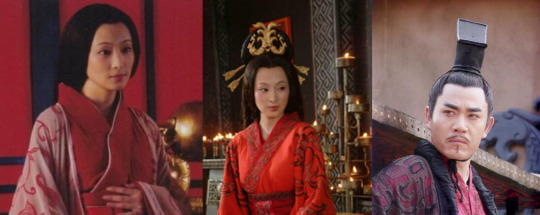
Tang Dynasty 618 - 907 AD(source: I used the concept art from The Longest Day in Chang’an)
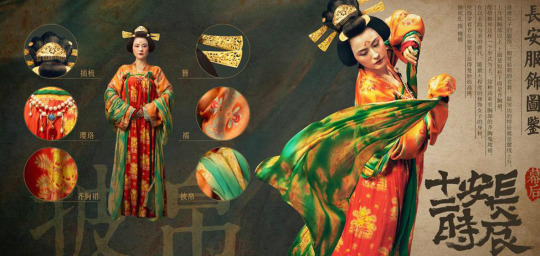
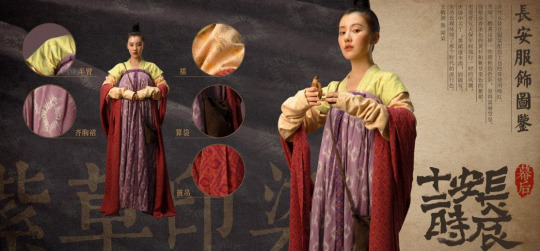
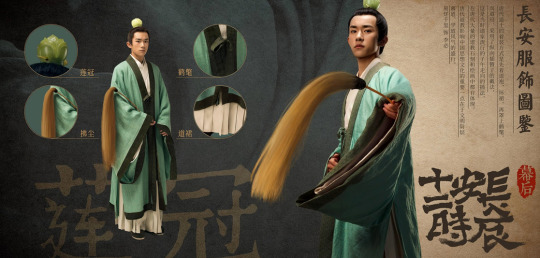
Song Dynasty: 960 - 1279 AD(Source: The Story of Ming Lan. note the change in hair style from left to right for Minglan for “married” and “maiden” look)
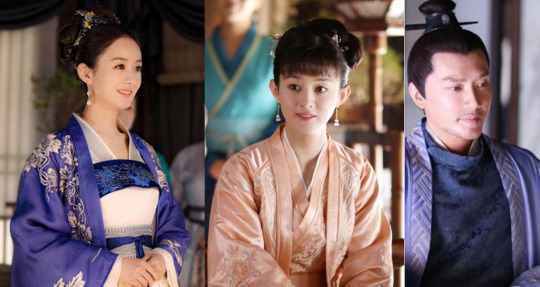
Ming Dynasty: 1368 - 1644 AD And Jiggy’s ugly hat makes an appearance! I it doesn’t look as ridiculous on this guy >:)
(Source: Under the Power, also I’d take this show’s style with a grain of salt because it’s not that accurate. I just wanted to show Jiggy’s ugly hat.)
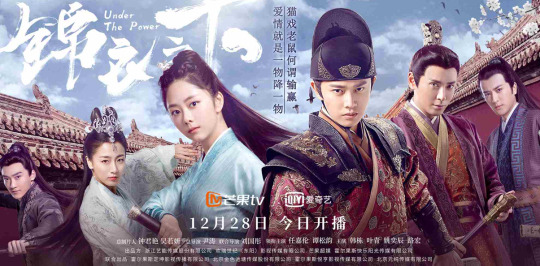
This one is an old show called The Great Ming Dynasty (Da Ming Wang Chao), also one I watched with my folks when I was a kid. I wanted to show this guy because he’s the emperor, and he has the down hairstyle very infrequently seen in dynastic dramas BECAUSE he doesn’t really care about politics and he spends all his time practicing taoist cultivation (yes cultivation, but like not the CQL type with magic, this is a purely political/historical drama). He’s also kind of crazy in the show so.
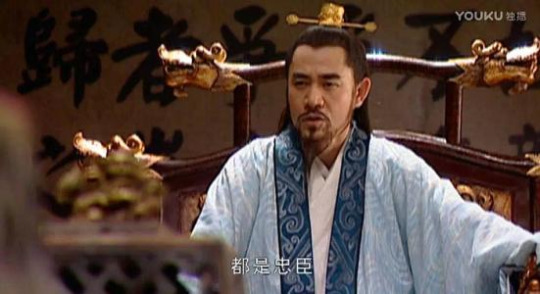
I’m not going to include the Qing dynasty because fashion changed dramatically within recent history because of the introduction of Manchurian rule in mainland china. But as promised, some men jianghu styles ft martial artists, cultivators, immortals and gods. I threw in a couple of ladies just for kicks, just to show you know… varying in style that we could’ve had but didn’t. (sources: The Return of the Condor Heroes; Journey of the Flower; Three Lives, Three Worlds, Ten Thousand Miles of Peach Blossoms)


26 notes
·
View notes
Text
A Easy Prepare For Embed Google Map
just How Does Google Maps generate Income?
By downloading this file as well as opening it in Google Earth, users are able to browse hillshades with two lighting angles for faults in the north San Andreas fault system. The degree of the LiDAR data is revealed by the cyan colored details. The hillshades will load when the customer has zoomed into a location of interest.
Why is there no voice on my Google Maps?
How to resolve “Google Maps not talking” issue in Android. Check your device's volume. Make sure voice is turned on in the Maps app. Clear the app's cache.
With one click of the computer mouse, a Google Planet customer can switch over to Sky Mode and reverse the perspective. With hi-res pictures from NASA, the Digital Study Consortium as well as the Sloan Digital Skies Survey, Google Earth has actually created an accurate and fascinating look at celestial spaces. Individuals can fly around, just like in Planet setting, to look the much reaches of room. Google Earth has actually produced 3-D structures for numerous significant UNITED STATE cities. Generally, they're not outlined replicas-- they're simple, gray 3-D drawings-- but you do get an excellent feeling for the city when you turn on this layer.
One can likewise upload an entire documents of places and also addresses and also pick different base maps. It's additionally very easy to export maps as KMZ documents and also open in Google Planet to produce an excursion. All this and also extra is explained in their Assistance Overview. These maps may be seen inGoogle Planet with our KML links in My Places or in the Gallery layer of Google Planet, Rumsey Historical Maps layer, or directly in the no download Google Earth Internet browser.
Quick & Easy Tips For using Google My organization and Also Google Maps For search Engine Optimization.
A minimal group can also be seen in the Google Maps audience on this website. Planet Map's information is split right into thematic teams and allows the customer to imagine layers as well as to produce data to explain the areas of rate of interest.

Scroll down under the editor as well as discover the https://googlemapembed.com MapPress area.
Most likely to the page or article that you want to include a Google map too.
Insert your Google API secret right into the proper box and click the "Conserve Modifications" switch.
This short article illustrates exactly how nonspecialists made use of Google Planet ™, a complimentary program, to produce community maps. In 2006, Google Earth started supplying detailed photos of identified areas in Israel. Likewise revealed was the supposed headquarters of Mossad, Israel's foreign knowledge solution, whose area is extremely categorized. The Google Earth API was a cost-free beta solution, enabling individuals to place a variation of Google Planet right into websites.
Each of these versions of Google Planet can be used to review as well as produce information in KML style, which makes it possible for instructors, pupils, and various other users to share data. Google Planet for Web - A simple to utilize, browser-based variation that offers ease of ease of access however is restricted in regards to performance. The sound, pictures, photos, as well as videos are credited under the media property, with the exception of marketing pictures, which typically link to an additional page that contains the media credit report. The Legal rights Owner for media is the person or group credited.

reasons To add Your service To Google Maps.
How many miles should you walk a day?
The average American walks 3,000 to 4,000 steps a day, or roughly 1.5 to 2 miles. It's a good idea to find out how many steps a day you walk now, as your own baseline. Then you can work up toward the goal of 10,000 steps by aiming to add 1,000 extra steps a day every two weeks.
Creation devices are currently offered in Google Planet on web. You can view your tasks on mobile and tablet gadgets making use of the most up to date variation of our iOS or Android app. Many thanks to a combination with Google Drive, you can share your stories with your target market and also they can see it anywhere-- their phone, tablet or laptop. Most importantly, you can welcome others to team up as well as co-author tasks with you. With creation tools in Google Planet, you can attract your very own placemarks, lines and also shapes, after that connect your own custom-made text, pictures, and videos to these places.

How can I track my husbands car without him knowing?
Spyine is the most popular phone monitoring solution on the internet. You can use it to keep an eye on your husband 24x7, without him finding out about it. It can monitor your husband's phone regardless of whether it is an Android smartphone or an iOS phone. All this happens with complete data security in mind.
The mobile variations of Google Earth can utilize multi-touch interfaces to proceed the world, zoom or revolve the sight, and also enable to choose the present place. An automobile variation of Google Earth was made available in the 2010 Audi A8. On February 27, 2020, Google opened up its online variation of Planet to web browsers like Firefox, Edge, and Opera.
How far back can Google Earth go?
Earth Engine is a platform for scientific analysis and visualization of geospatial datasets, for academic, non-profit, business and government users. Earth Engine hosts satellite imagery and stores it in a public data archive that includes historical earth images going back more than forty years.
Some are constructed right into the application, however mostly Google is currently letting users produce and import 3-D illustrations themselves making use of the cost-free Google SketchUp program. Just like any kind of various other view, you can make use of the "tilt" as well as "rotate" buttons in the navigator panel to obtain the full 3-D view. In this section, we've covered the majority of the basic functions of Google Earth.
This Is Google's New Smart screen device.
With a collection, for instance, there is a huge operational benefit to having a real location, an actual audience and a trusted community goal as a structure for the future. The shelf-life of modern technology firms, their applications, their tools as well as also details itself is unnervingly brief, about the transformative drift of an area.
Earth Map consequently gives users both a temporal and also a spatial viewpoint to their locations of interest. Its attributes are based on Google Planet Engine's big data capacities, enabling individuals to take on complex evaluation of planet monitoring, ecological as well as environment information in a straightforward fashion. Fish and also Wild animals employees appropriately use Google mapping software program and recognize its limitations and uses. There are several scenarios where Google mapping software can be a valuable and efficient device to help our job. FWS team need to comprehend the proper application and use Google software.
They counted produce types by aesthetic inspection or by examining a menu. Supermarket and also dining establishments were ranked according to a system created by the authors that utilized the selection as well as top quality or freshness of produce. The score and address information were tabulated and also moved from a spreadsheet to the Google Earth And also program, which outlined geo-coordinates for the data points. Maps are made use of to track illness and illustrate the social context of health issue. Nonetheless, commercial mapping software program requires unique training.
1 note
·
View note
Note
Hiii! A new fan of the Medici series! May I ask, overall is it close to being historically accurate or does the show try to be faithful to it? And this is a short series? I’m sorry to bother! Additionally, what are your fave things about the show/characters?
no bother at all, i love talking about this show! it is indeed a pretty short series, there’s only 2 seasons, each with 8 episodes. season 3 is coming out in italy in a few weeks (so hopefully will be on netflix this winter) and this will be the last season focused on the medici, though they’re going to then do a couple spinoff-ish seasons about da vinci and some other artists
as for historical accuracy, you definitely have to take everything in the show with several grains of salt haha i want to preface this part by saying that i haven’t formally studied this time period at all, i’ve just done some reading on my own about the events of s2 so i’m by no means an expert! but from what i gather, s1 goes pretty wild with inventing events left and right and almost none of the major events in s1 actually happened, whereas s2 sticks fairly closely to real events (at least the political-related events), although of course the details of these events are changed, exaggerated, and given a heavy pro-medici and pro-lorenzo bias. personal events (affairs, all the different dynamics between the characters, etc) are obviously more fictionalized, exaggerated, or invented altogether than the political events. as for the historical aspects like fashion, hairstyles, architecture, etc. i don’t know anything at all about that stuff so you’d have to ask someone else!
ok now on to my fav things about the show haha first of all it’s such an aesthetically pleasing show, i love the costumes and the scenery and the cinematography (and the gorgeous actors lmfao) and the MUSIC i love the music so much! i also love how it’s kind of like Period Drama Lite, i saw an interview where one of the show creators said that he tried to make it a period drama for people who don’t normally like period dramas and i think that’s totally an accurate description. it’s showing history, but something about it feels modern, and i know some people don’t like when people try to put a contemporary spin on real historical events or retell them in a way that connects to modern issues, but personally i really like that aspect bc to me it makes history feel even more alive and relevant! (plus in school i had a particular interest in classical reception so i was always thinkin about how ancient history and culture has been received and retold in the modern era, and now i like to wear that hat whenever i consume any piece of historical fiction media)
and finally i love the characters and their relationships with each other, i love that the showrunners were able to shove a bunch of renaissance bankers at me and make me care so deeply about them (who would’ve thought i could be waiting on the edge of my seat to see if a vote about taxes will pass or not?). francesco pazzi in particular Changed My Life and i’m grateful for it every day. i’m sorry this answer got so long but i had a lot of things to say sdfjgk anyway i hope you’re enjoying the show so far!!
3 notes
·
View notes
Text
Anon submits the following question:
Hello there! I am writing a story that has a couple characters time travelling to today from 2000 years in the future. One is a regular human and the other is his pet wooly mammoth that is illusioned to look like today’s elephant and they can talk to each other via implant that reads and translate brain waves.
His reason for visiting is 1) Collect DNA to use in more extinct species revival. 2) Collect today’s digital equipment because in the future, equipment there is too new to read old data. 3) Collect artefacts before they get destroyed in the future especially ones from his ancestor.
My main problem is keeping it consistent. First of all, he needs to speak and look like modern day people. However, his reason for coming is because he can’t read today’s media because the futuristic equipment can’t read it and today’s artefacts get destroyed in the future, which means exactly how much access does he even have to modern day. So, isn’t it going to look more like modern day people trying to understand 2000 years ago?
Obviously, the big reason we can’t understand people 2000 years ago is because things got lost and at the time there is no technology to preserve them. Anyone travelling back 2000 years ago from today will always be out of place. It should be easier for people in the future to understand today because of all our technology to preserve things, however my kink in the story is obviously today’s equipment is outdated.
But I don’t know, should there still be enough data that does survive and transferred to new technology. I mean, there are cassette tape to mp3 converters and video tapes get converted to dvds. But I do have some 20 year old video camera tapes, 3 ½ inch floppy disks and Windows 3.1 game CDs I can no longer play and no company releasing them for modern computers so it does make sense I think? But of course there are things that are just.. well completely lost and gone.
Please help, thanks.
Saphira: These are issues that will be expected by the time traveler. He knows full well that he does not have all the data- which we can use to our advantage.
The way to bridge his knowledge when he first lands from the future and actually blending in can be super exciting. How he learns to blend in accurately is a Stake Out, or perhaps a series of tests so he can self-calibrate.
This time allows him to be participatory, but passive. It allows him to take in the environment, process the information, and update what information he came with. Now we already know the modern world; so this frees you up to play with his expectations! What did he get wrong? What did he get right? What takes him by surprise? How does he handle the situation of people not reacting well to an Elephant?
The Adjustment Period can set the pace for your consistency. It can also outline his goals, and how he makes plans. Have fun with this time. This is also the easiest period to add comedy that later turns into a crisis!
Feral: So, would someone from 2018 traveling back in time to the Romanized Europe in 18 AD be out of place? Sure, mores have changed; hygiene has changed; language has certainly changed. But that doesn't mean they wouldn't know anything. We have archeology and anthropology and historical linguistics. Would Romans notice it was a bit off? Probably, but someone whose job it is to go back in time has probably done a lot of research (or has a team doing the research for them) to be as accurate as possible. You mention that all artifacts from our time are destroyed in the future? Like, every single material product of all world societies is destroyed completely beyond reconstruction? That sounds a little extreme. Did the planet blow up? Because Pompeii was destroyed by a volcano. Heraklion is under 10 meters/30 feet of water. We've got ancient cities and hill forts and tombs and a just a bunch of pottery shards buried under the ground that we are constantly unearthing and learning more about the societies that predate ours.
Maybe he wouldn't know how to turn on an iMac, but would he necessarily know nothing? No cookbooks or fashion magazines or any of the hundreds of tons worth of printed material we produce each year survived - it all gets destroyed? And yeah, maybe they get the clothing mixed up between decades (we do for the fashion of just a few decades ago) and pair Jenkos with a velour track suit top, but that's part of the fun with time travel. What people get right and what people get wrong. How people react to the specific mistakes the time traveler makes is a great source of conflict for your story.
Brainstormed: How much support did he have before jumping back? How much preparation? The language (I'm assuming English?) has changed, not even accounting for the slang. Food has changed, and the customs of eating it, so is his palate suited to today's food or will he be disgusted? Common social customs like greeting and small talk have probably warped too. Hygiene may be different. He's carrying germs that are stronger than today's germs by 2000 years, will he get everyone around him sick? Your character may be focused on technology, but a good way to show consistency and the disparity between his time and today is the little things that he may not have prepared for that have nothing to do with technology. Aside from that, if none of his future tech is compatible with today, then just have him acquire some modern technology like a phone or laptop. Have him grouse at how slow or stupid or limited it is, and how future technology is so much better, which gives you a chance to illustrate the changes tech will undergo in the future.
Constablewrites: Also give some thought to how much of a focus you want the fish-out-of-water stuff to be in relation to the larger story. It's perfectly fine to make the story about that jarring change. It's also fine to decide that having to come up with new ways of describing stuff your audience is already familiar with is getting tedious, and you're just going to give your traveler a crash course and get on with things.
Feral: As an addendum to how everything was destroyed... how did the DNA of the woolly mammoth survive to be cloned? And how did they know to disguise it as an elephant? That would suggest that the future people do understand something about their past although they are simultaneously ignorant of the absolute panic that would result from an elephant traipsing around outside a zoo (unless this happens to take place in one of the few locations where elephants are just roaming around and doing their thing). Honestly I think most people in 2018 would react to bizarre clothing with a shrug - it must be a prank or a party or a cosplayer doing a character I've never seen - but the elephant is much more extreme. It sounds like the kind of detail that would be in something more absurdist in tone and/or genre. If you plan on having a bunch New Yorkers or Londoners or whoever-ers just roll with an 11 ft, 13000 pound animal hanging out, then honestly, anything can happen! Any reactions to the time traveler's dress or behavior or speech would theoretically be acceptable to the reader.
17 notes
·
View notes